- by Ingemar Borelius
Why this?
I’ve written
this article to try to expose a few driving factors behind the creation of the
modern Flatcoat. Why are we where we are today, where are we heading, where do
we want to be, what could be done to turn things into another direction? I will
humbly say I don’t have all the answers, you could probably tell much better
than I can. I’m sure many of you will be upset and question what I’m telling.
My intention for sure is to provoke a bit to get a dialogue started that might
move things in a better direction. But I can assure you I’ve done it for the
best of the breed we all love.
About me.
I came into the breed in 1971 when we had our first Flatcoat. Having a strong interest in general history I believe I must have looked into the Flatcoat history from day one and it didn’t take long before I had Nancy Laughton’s magnificent biography,” A review of the Flatcoated Retriever”, on my desk. I started to dig into Flatcoat pedigrees to try to find out how the top dogs were bred. Within a few years I was asked to accept the role as” breeding advisor” for Flatcoats, in the Spaniel and Retriever Club, a role being mainly designed for unexperienced breeders asking for advice about suitable stud dogs and combinations. In 1979, I became Field Trial secretary for the local Spaniel & Retriever Club, I participated in the making of the Swedish Flatcoat Club and became the vice chairman and I wrote about the Flatcoat history for the very first Club newsletter.
We had a number of Flatcoats over these years, three dogs from Colin Wells and one from Joan Marsden, a few homebred dogs and we had some litters. We were showing the first ones quite actively but turned gradually towards the working side of the breed and the first one became one of the first Flatcoated Dual Champions in Sweden. Over all these years we made numerous trips to England and corresponded regularly with Nancy Laughton, Gwen Knight, Colin Wells, Amelia Jessel, Joan Marsden and many others including Read Flowers, Peter and Shirley Johnson, Joan Mason and US breeders Ed Atkins, Sally Terroux, Elisabeth “Biz” Reed and Bunny Millikin. I’m quite sure many of those were quite fed up with my never-ending questions about the breed but I might have returned some value and I had the regular Christmas greetings from Nancy and Gwen until the very end which pleased me a lot. I wrote a lot about the breed, I made the original translation of the current breed standard, corresponding with Nancy Laughton about the reasoning behind some of the somewhat cryptic formulations and I made the first version of a brochure with a detailed description of the breed type and conformation.
I’m recently retired, I’m a honorary member of the club and my active” dog years” are many years behind. I left my Flatcoat library to the Swedish Kennel Club many years ago but there’s still a lot of articles and writings stored in my computer. I thought I might have some useful knowledge there for the younger generations and some thoughts about the driving factors behind the transformation of the breed to become what it is today. I’m sure some of these thoughts might be heretical and challenge some of the strong conventions governing the breed. But I can assure you I’ve expressed those thoughts for the prosperity of this lovely breed and maybe it can raise some fruitful dialogues that might be beneficial. I have a strong belief that we could learn from history, from wise men and women in the past. So, to make a change I believe we need to look back and try to draw some conclusions out of the history of the breed.
The foundation years
A Canadian breed with ancient European roots is the origin of all Retriever breeds. It was shaped by the so-called Water Dogs that early French, Spanish, Portuguese and English settlers brought from their homelands. Fishermen from these countries began to exploit the fishy waters around the neighbouring Newfoundland and Labrador areas on the Canadian east coast in the mid-sixteen centuries. When the fishermen settled in this area and fishing harbours were built a hundred years later, it was quite natural for them to bring their working dogs. The Water Dog, or the Water Spaniel using the most common British name, had existed in various forms in southern and central Europe since ancient times. It was developed to act as a shooting dog, a retriever. In addition to the fact that it is the forefather of all retriever breeds, it’s also the origin of numerous modern European Water Dog breeds where the Poodle, the Water Spaniel, and the Lagotto Romagnolo are the most well-known ones, but there are many others as well.
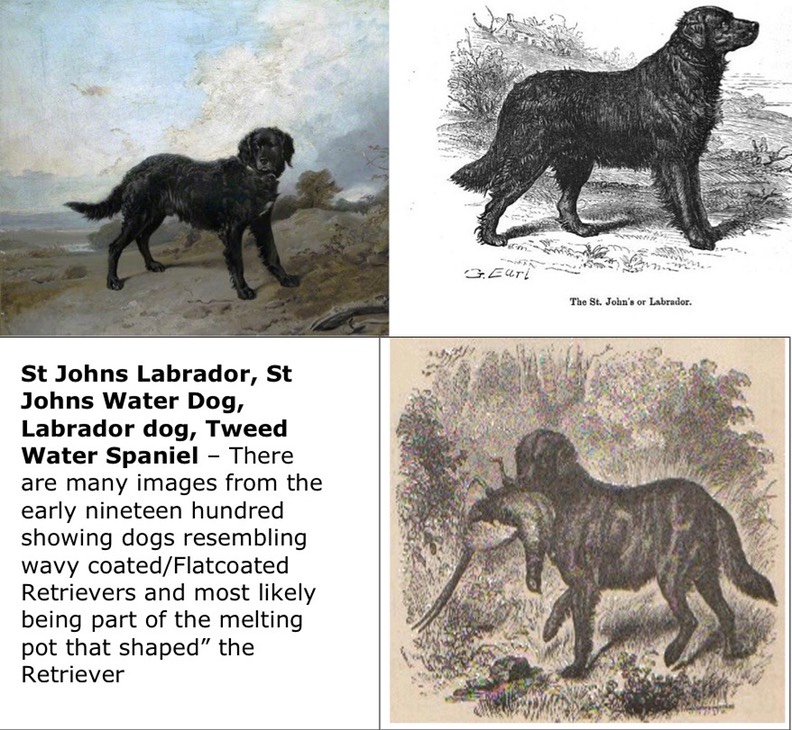
I prefer to call this dog the Canadian water dog to avoid any confusion with the modern British breeds named the Labrador Retriever and the Newfoundland dog. There are many imaginative stories about the usage of this dog. And there is certainly evidence that they occasionally swam after a tamp of a net and retrieved half-dead fishes fallen out of the nets. But they hardly had their most important task on the fishermen’s boats. Their main roles were along the guns in the mosaic of lakes and coves forming the Canadian east coast. They were used as gundogs to find, raise and retrieve wildfowl. There are many classic paintings on which water dogs, similar to our modern retrievers and spaniels, appear and they are also mentioned in ancient literature. But they varied quite a lot in appearance. There was of course no decision body at that time to decide upon their looks. Like many other early breeds these dogs were shaped when breeding from the ones best suited to perform their tasks, with a body constitution and coat that was suited to stand the rough and often icy Canadian waters and with a size that made it easy to lift them into the shooting man’s boat. Boats transporting fish from Newfoundland to Britain brought these water dogs. It was soon discovered by the dog-loving Englishmen and an increasing number of water-dogs were sold to the British dog fancy.
The fact that the European water dogs were called Water spaniels in Britain is an expression of the same phenomenon as the names given to the Canadian water dogs. The British Water Dog named Water Spaniel might originate from Spain in the dawn of history, even though Water Dogs existed in most parts of the continent. But the name was also due to the fact that breeders wanted to give these dogs an exotic touch. Thus, the Canadian water dogs got their different names in England after the great island of Newfoundland, its capital St. John or the Labrador Peninsula on the nearby mainland, places these dogs happened to come from. Similarly, early breeders of the long-coated yellow retriever used the term Russian Retriever claiming that the original dogs were bought on a Russian circus. But they were all basically the same breed, the same Water Dog with the individual variations that occurred long before the breed standards were agreed upon and the world of dog shows started to group these dogs according to different coats and colouring. In general, the Canadian water dog was a medium sized dog with a rough coat, a fast, racy and powerful dog, shaped for work. It was found in both long and short-coated varieties, in varying colours and sometimes being multi-coloured.
” The Retriever”
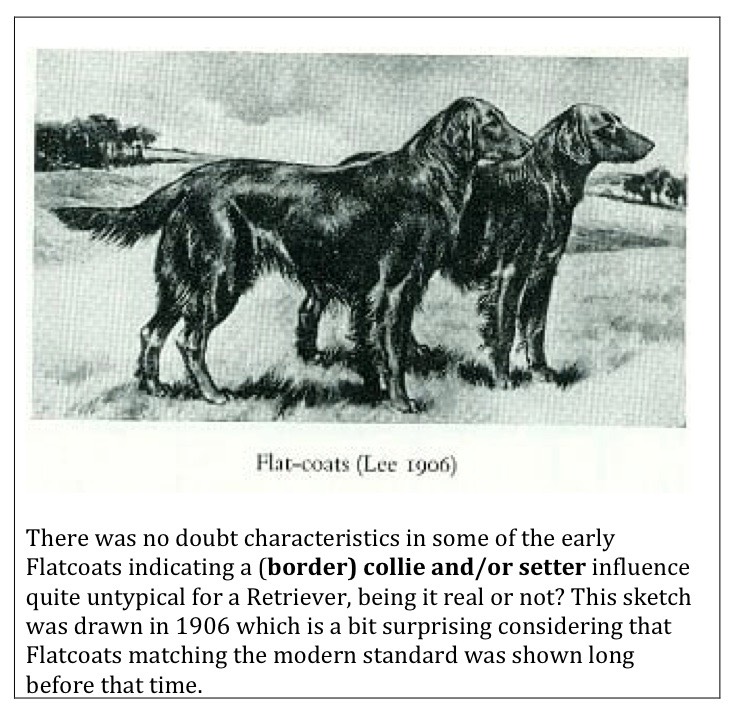
The early retriever story began when large shots were established on British estates during the first half of the nineteenth century. According to Wikipedia it was the introduction of a fully functional hinged breech loading shot gun in the 1830s and of the modern cartridges that was the birth of the modern shotgun. Thus, quick shots on driven game was enabled and game shooting became the highest fashion, were a line of noble men and sometimes women, supported by their personal gamekeepers rapidly loading a pair of shotguns, were waiting for beaters to raise the game. The Canadian water dogs proved to be ideal for these shooting conditions being steady to live game and strongly focusing on the retrieving of dead game. The classical gundogs (Setters / pointers / spaniels) with their stronger inclination to hunt were soon disqualified.
The fact that the curly- and wavy (later flat coated) retriever varieties didn’t inherit any of the Canadian names, like for example the St. Johns dog, is most probably due to the fact that it was” The Retriever” from the very beginning. When a native English breed was formed it was simply called” Retriever” but when dog shows became fashionable among wealthy gentlemen, at the end of the nineteenth century, a classification scheme was needed. Retrievers were divided in different classes due to their coat and colouring. Retriever – curly coated and Retriever – wavy coated became the most common ones. But Retriever – rough coated, Retriever - smooth coated and soon Retriever - yellow were shown as well indicating that coats appeared in all shapes and that the forefathers of the Labrador and the Golden were shown under other names long before these varieties were accepted as independent breeds. Changing fashions and probably a limited infusion of blood from setters and border collies gradually changed the wavy coated variety to the Flatcoated one. It was by far the most popular retriever until the Labrador Retriever was accepted as an independent breed in 1903 and the Golden Retriever in 1911.
There are many different descriptions of how the Retriever was formed, some of these of later date and often rather simplified. The Labrador retriever was originally created at a few British country estates in the early 1830s. This is well documented in the local kennel registries from these estates. It was claimed that their stock came from pure bred Canadian dogs, but it is generally believed that pointers and other local gundogs were used as well. A similar documentation is kept about the origin of the Golden Retriever where the yellow wavy coated Retriever called Nous was mated to a Tweed Water Spaniel in 1864 building the base for the yellow retriever that, according to Wikipedia, was registered as Flatcoat – Golden in 1903 and renamed to Golden or Yellow Retriever in 1911.
Even if there is no known documentation of a similar kind about the early long-coated retriever varieties it was most certainly established at the same time as the Labrador during the first half of the nineteenth century. The introduction of the modern shotgun and large-scale rearing of gamebirds at the major estates radically transformed country life all over England. The breeding of the very first specialised retrievers went along with that and knowing that there are pictures of quite typical Flatcoated Retrievers as early as around 1860 clearly indicates that the shaping of that breed must have started many generations before. There are several indications that the Canadian Water Dog was mated to black setters and sheepdogs even though there is no known written evidence or registry clarifying how and when it happened. But we should never forget that breeders were trying to shape a specialised Retriever and thus dogs able to strengthen these retrieving capabilities were dominating. It’s no doubt that all the Retriever varieties were shaped via crosses between the Canadian water dog and local British gundogs, but most certainly the Canadian water dog was the dominating component in all retriever breeds.
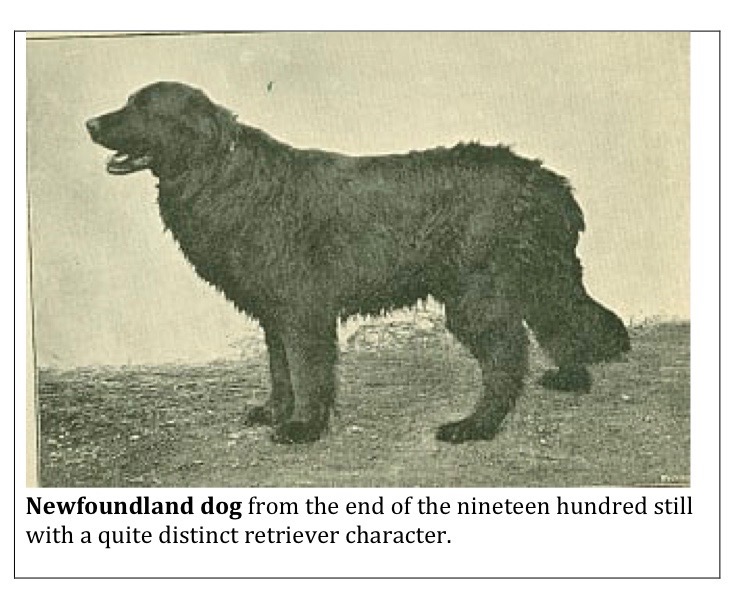
A forefather of mine was a naval officer and sailed on North America at the beginning of his career. In a letter to his brother, dated in southern Sweden 1852, he tells that he lacked a woman to marry and jokes about his Newfoundland bitch Lady for being his only loyal friend. According to local dog books it is long before the breed is noticed on the Swedish ground. But there are no reasons to believe that Lady was completely unique. We shouldn’t believe either that this dog had that much in common with the coarse Newfoundland dog of today. According to an otherwise rather imaginative description on Wikipedia, it is the result of crossings in Britain between the Canadian water dog and the St. Bernard and the Mastiff at the end of the nineteenth century. The intention was to radically increase the size of these dogs and like most other descendants of the Canadian water dog it is mainly designed in Britain. My ancestor’s Lady was more likely a dog of a similar type and character as our current Flatcoated Retriever. He was an active shooting man and most probably Lady was used for shooting purposes.
Getting its modern shape
These Retrievers quickly became popular and breeders were active all over Britain. In a tiny little brochure about the Flatcoat (from a series of books named A Complete Anthology of the Dog/Vintage dog books 2010) gathering extracts from old books, Hugh Dalziel states in his article from 1875 that” the flat or wavy coated retriever is now well distributed throughout the British Isles and few shooting companies leave home without a well-trained specimen or two”. There was no dog registry at that time and breeders had of course a full freedom to cross to any other breed. But anyone who have tried to breed a first class working dog of any breed knows about the challenges. So even if tales about crosses with setter/pointers and border collies are true it seems obvious that the Canadian water dog and other Water Dogs dominated the pedigrees. And when the old Flatcoat pedigrees show known dog names, they were wavy coated for sure. Although single Labradors are named in these early pedigrees, they were most likely imported Canadian water dogs and not what is called the Labrador today. Several early pedigrees extend back to the 1850s. But the named wavy coats figuring in the first generations and early pictures of quite typical Flatcoats indicate that similar dogs had been around many generations before.
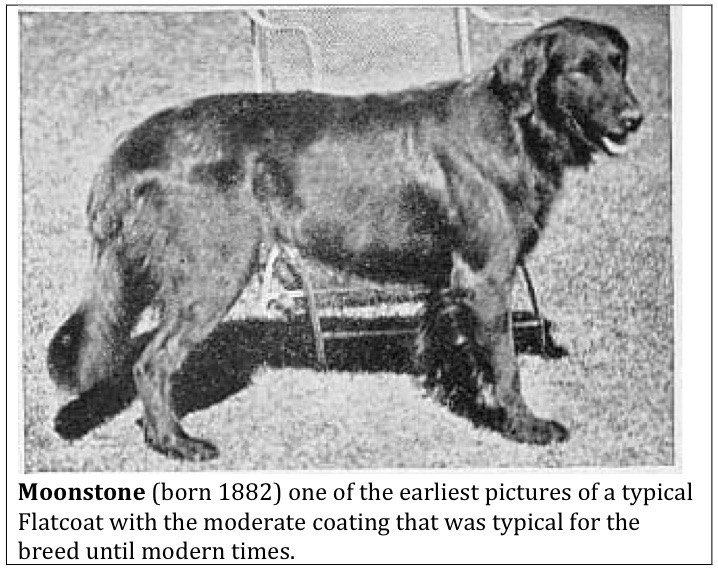
The individual breeder who played the foremost role when the Flatcoat was formed was Sewallis Shirley, coming from an old noble family. Like most other men from the British nobility he devoted himself to various sports. He had a large kennel with Fox Terriers, Bulldogs, Collies and diverse types of Retrievers. He was active in arranging some of the first dog shows and he was judging some of the first Field trials organized in the 1870s. He founded The Kennel Club inviting a small group of men to set uniform rules for the dog shows and to establish a registry for purebred dogs. He played a leading role when the Flatcoat got its current type and his Moonstone (f.1882) had a conformation that would have been competitive in modern times. It wouldn’t be a wild guess to think that he crossed his retrievers at an early stage with his sheep dogs contributing to the flat coat and the typical Flatcoat head. But given the excellent type and quality shown by Moonstone and his grandson Darenth its likely to believe that these crosses had taken place much earlier. In the Hugh Dalziel article noted above he states that” Mr Shirley remembers black retrievers at his family estate Ettington Park (today being an elegant hotel outside Stratford-Upon-Avon) more than forty years ago. In addition to those the neighbouring gentry had strains of their own that Mr Shirley made use of when founding his kennel.” Then we are around 1835 so it shouldn’t be no doubts that the breed was established during the first decades of the nineteen hundred.
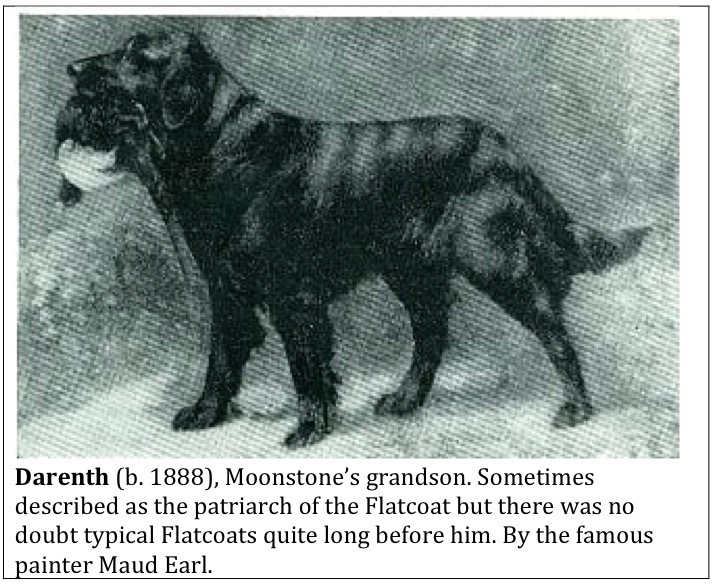
Even if it took some time before the breed got its current name it’s obvious that the Flatcoat got its modern shape quite early. Darenth (born 1888), the grandchild of Moonstone, is sometimes described as the patriarch of the breed and it’s no doubt that he exposed a Retriever-type that would be viable at modern shows. He had a rather complete at least six-generation pedigree behind him. Among these dogs, no other breeds appear with the exception for some dogs far behind described as Labradors and most likely being, more or less, "purebred" Canadian dogs. Looking at the depth of this pedigree wavy coats/flat coats no doubt was around during the first decades of the 19th century.
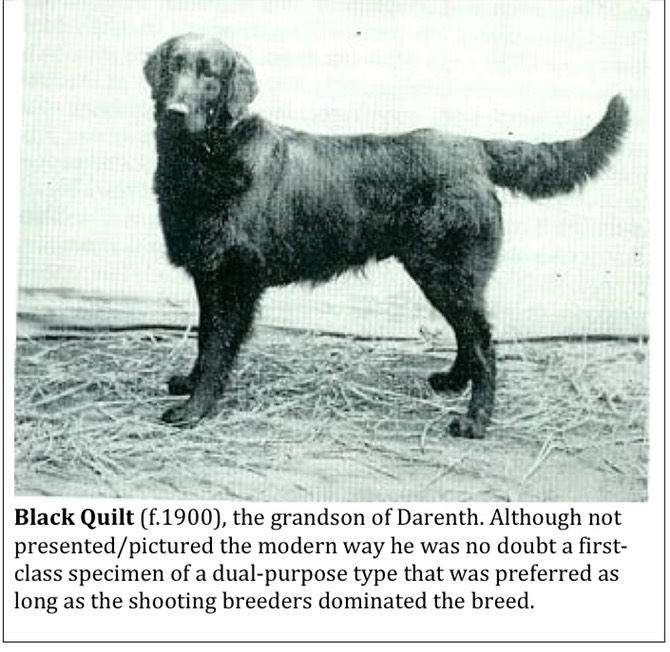
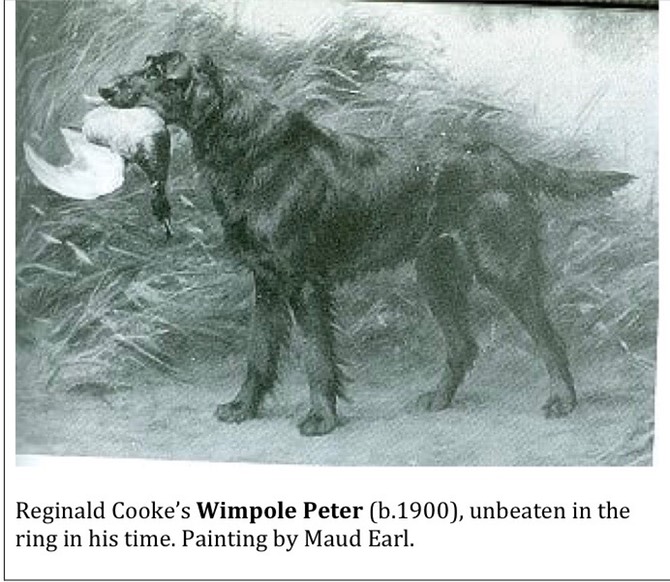
The fact that we can recognise the current Flatcoat when watching photos of these early Flatcoats isn’t that strange. The stars of the nineteen thirties were linebred repeatedly to the best individuals of the late nineteenth century. And the dogs that were used as the foundation of the post-war Flatcoat are correspondingly linebred to the stars of the thirties. The visible changes that must be obvious for anyone is that the show dog has gradually changed into a somewhat heavier, higher, longer dog with a heavier coat and feathering than the old time Retrievers, being shaped by the timeless demands of the shooting field.
Early Flatcoats around the world
According to Wikipedia the Swedish King Oscar II initiated the first pheasantries on royal shooting grounds just outside Stockholm in 1846, followed by a few noble estates in southern Sweden. However, all these attempts failed and it was not until 1879 when the industrialist and dog man, the Baron Oscar Dickson, made a successful attempt on his shooting grounds in western Sweden. Its documented that up to 4 000 pheasants a year was reared on his estate where the Swedish nobility and the royal family was invited to great shooting parties. Dickson had a Scottish family background and strong business connections with England. He was introduced in the British noble class and saw the Prince of Wales as a shooting friend. He must have seen numerous Flatcoats on the British shooting grounds and he probably had god options to obtain the very best blood when importing the first Flatcoats to Sweden. Dickson was a passionate dog man, he knew the Flatcoat man and Kennel Club founder Mr Sewallis Shirley and he became one of the founding fathers for the Swedish Kennel Club in 1889.
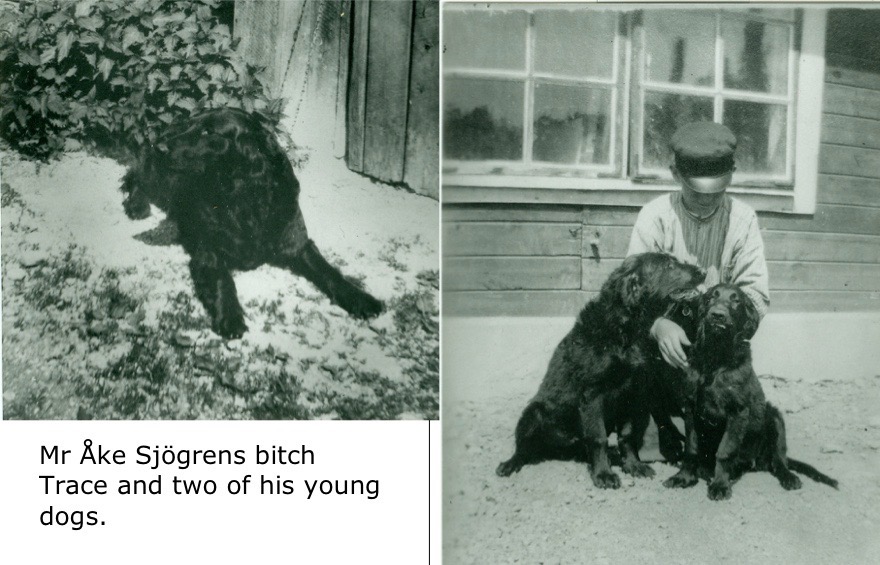
Mr Åke Sjögren, whose wife came from the famous Nobel family, was a famous shooting man who owned the Mälsåker estate at lake Mälaren not far from Stockholm. Just like Mr Dickson he established a large shot with reared pheasants and arranged shooting parties with the King and the Princes arriving in chartered trains from Stockholm. He owned a number of beautiful Flatcoats but when he became bankrupt in 1915 he had to sell his dogs and the breed became extinct for about fifty years in Sweden. When I got in touch with his granddaughter many years ago she could expose a family album with beautiful pictures of the most typical working Flatcoats. According to the notations in this photo album there were early Flatcoats in Norway and we know there were Flatcoats in Denmark as well at that time.
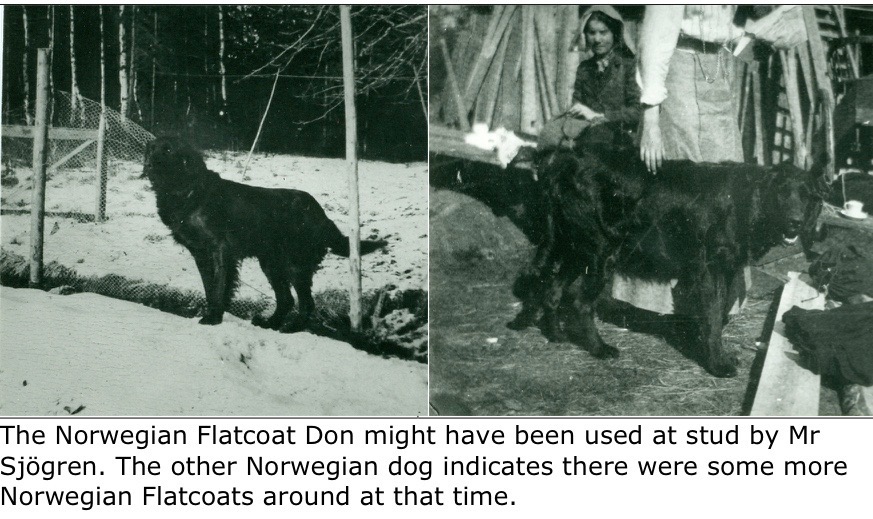
There were quite many Flatcoats exported to USA from the beginning of the century until the end of the nineteen forties. But as it seems there were no attempts to establish the breed and very few litters were born. The birth of the modern US strains could be dated to 1953 when Pewcroft Prefect and a few others was exported from Britain and serious breeding programs were started. I’m quite sure there are early Flatcoats as well in many other countries where country life in the noble classes was inspired by the British way of living but it has unfortunately left no traces in modern Flatcoat pedigrees
Early Field trials
It’s an evident fact in all breeding that good capabilities are developed via selective and targeted breeding, where dogs with the desired capabilities are used at stud and dogs with undesired traits are not bred from. In all ambitious gundog breeding programs, the logic is that stud dogs should be well tested at relevant gundog tests and having proved first class gundog qualities. From experience (and by genetical logics) breeding results are significantly improved if the same goes for previous generations. Good individuals from strong work merited lines produce better and more even litters than dogs with a poor or mixed background from a working point of view.
These are facts that are obvious when you look at the British gundog scene. You can easily follow the good gundog lines from generation to generation as far back as to the beginning of the last century, when the retriever was stabilized in different breeds. Even in the working Flatcoat numerously small working lines have been maintained over the decades. Thus, a good working standard has been kept despite the low odds compared with the breeding of the strongly dominating working Labrador and the working Golden. The latter being smaller in numbers but still competitive when it comes to the top honours in the field.
It’s a fact in the British gundog world that proper Field Trials on real game are considered to be the only relevant test bench to evaluate gundog qualities. Field Trials, mostly running on pheasants or partridge but occasionally on rabbits, hare, duck, woodcock and snipe, set high demands when it comes to steadiness to shots and fallen game. Dogs are tested on a shooting line where handlers, dogs, judges and guns are either walking or standing in line. Game is either walked up by the line or driven by beaters towards the line. Shot game can drop either close to the line or on relatively long distances. One of the handlers is asked to send his/her dog on a specific piece of game at a suitable distance. For ethical reasons wounded game is prioritised and the successful retrieve of a so called “runner” gives extra credit to a dog. The dog is sent with hand signals to the fall and is asked to hunt the proper area discretely and quietly supported by his handler to avoid any unnecessary disturbances to unshot game.
To manage all different requirements and be successful a dog must be able to walk at heel without a lead and without any oral or physical corrections from its handler. The handler as well as the dog must be fully free to concentrate on the shooting situation and to mark fallen game with precision. The dog must be quiet and any squeaking or barking will immediately disqualify the dog from the trial. This is due to the fact that squeaking annoys guns as well as game and it’s evident that it is a strongly hereditary trait. When sent for a retrieve the dog is supposed to hunt the given area at a high speed, in an efficient hunting pattern, with a focused nose work and when needed in close dialogue with its handler giving signals to send the dog to a new area. The dog is supposed to react rapidly to the whistle and, with a positive attitude, follow a new hand signal. When game is found the dog is supposed to pick it up directly, carry it with a soft and steady mouth and deliver it rapidly to its handler. The term style summarizes the different qualities in a first class working Flatcoat shown via a balanced, happy and trustable attitude in all situations no matter if it’s at heel or in action, quietly waiting on a drive, following new directions without hesitation, hunting systematically and with eagerness for a fallen bird or delivering it rapidly, directly and with pleasure to its master’s hand. A stylish dog is built for work, with a conformation and size supporting a quick and easy moving action. The constantly wagging short tail, shown by a stylish worker, completes the picture of a thoroughbred working gundog.
So called working tests, on dummies or cold game, are used for training, as preparatory tests, to show the qualities of well-trained retrievers to the public, or just as a thrilling type of competition during spring and summer when no proper field trials take place. Working tests are not considered to give the full picture about the dogs working qualities and consequently they are considered by the British to be of less value for the breeding of high quality gundogs compared to the proper Field Trial. But knowing the limited number of Flatcoats entered at proper trials I believe that well-planned and demanding cold game tests could add considerable knowledge about individual dogs and litters, to be used for further evaluations and be beneficial for the breeding of the working retriever.
The first gundog Field Trial in Britain took place as early as 1875 but proper Field Trials for retrievers were established 1899 when ten dogs, one Irish Water spaniel, two Clumber Spaniels, one Field spaniel, one Curly Coat and five Flatcoats were entered at a two-day Field Trial with three Flatcoats at the top. In the year 1900 The Retriever Society was established with the aim to act as main body for Field trialling and from then on, a gradually increasing number of Field Trials have been arranged every year, with very few exceptions. The first Retriever Championship was arranged in 1909. Even if Field Trials in some ways have been changed over the years parts of the current set of rules were written for the first Field Trial arranged by the Retriever Society in 1900.
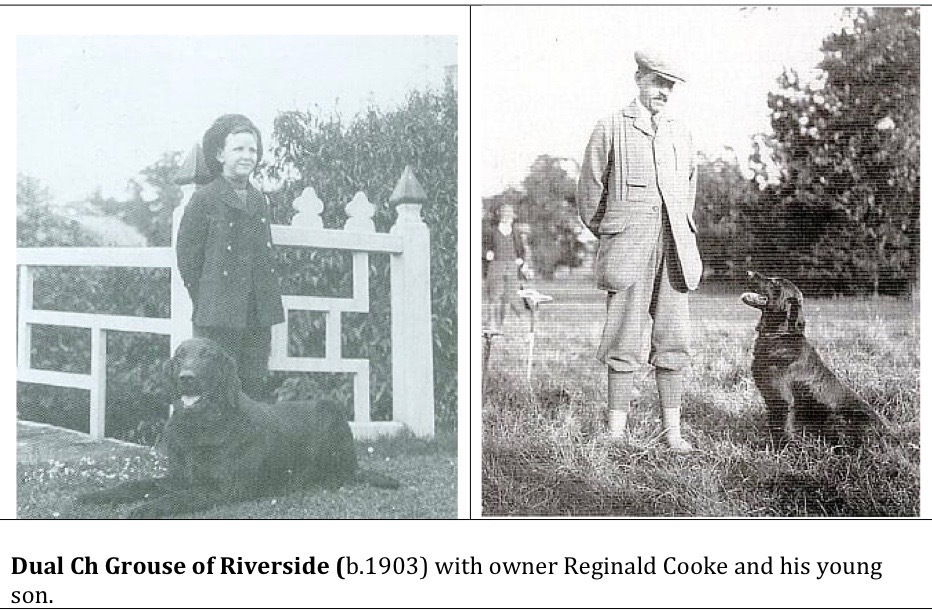
The Flatcoat was the dominating retriever in working circles at the end of the nineteenth century and up to 1907, when the Labrador retriever entered the scene with an immediate success. Fifteen Flatcoats, three Labradors and two other dogs were entered at the Kennel Club All Aged Stake and the three top honours were conquered by the Labs. 1909, when the first Retriever Championship was arranged, the Labrador had started to dominate the scene and 1911 all the contestants were Labradors.
The Labrador rapidly became the major working Retriever a position that has been maintained since then and, with very few exceptions, Labradors have won the British Retriever Championship every year until today. A liver Flatcoat, Meeru, won it in 1912 and was second 1913 in fierce competition with a card full of Labradors. Two Flatcoat/Lab Interbreds won in 1921 and 1922 and Goldens have won four times starting in 1937. The most ambitious trainers obviously choose the Labrador. The average Flatcoat was even at that time too big and too heavy to attract the average shooting men (and women) and most probably even then too unstable when it came to solid working characters. A big lumbering dog couldn’t work at a speed and in a working pattern that made it competitive at trials. Another point was that the smaller Labrador was more handy and easier to transport in yesterday’s cars.
One consequence of these conditions was that some of the most ambitious trainers turned to the Labrador and one of these was Captain Archie Butter, who started in working Flatcoats, but won the Championship in 1911 and 1914 with a Labrador. He is considered to be one of the best Retriever trainers of all times and he was far ahead of all other trainers when he, inspired by sheepdog trainers, started to use a whistle and hand signals as tools to direct a dog to the game as fast as possible and to minimize harm on unshot game. This method came into use very slowly and didn’t become a standard until twenty or thirty years later.
The report from the International Gundog League Field Trial 1907 gives the following interesting comment -” From one point of view Field Trials have meant something really positive, they have promoted a type of dogs whose working capacity is not limited by their conformation as is the fact among show bred dogs”. Already at that time, there was an obvious show ideal that wasn’t defined by the needs of the shooting man.
It’s no doubt that the US dog historian Scottie Westfall (Retrieverman.net) has a strong point stating: “The only way to breed working dogs is to actually work them to see which actually do have functional conformation and have the right behavior and temperament for the job.”
Declining popularity
The Labrador was developed as a pure shooting dog in relative obscurity at a number of British country estates for more than fifty years. As always, the nobility looked for a good looking shooting dog but it wasn’t too affected by the trends of the show world and the Labrador wasn’t recognized as an independent breed until 1903. The development of the Golden Retriever, was following a similar pattern and it wasn’t recognized as a breed of its own until 1911. Within a decade both breeds superseded the Flatcoat in the popularity league. In general, these dogs were smaller and more phlegmatic than the Flatcoat and thus more easily handled.
It could be said that the Flatcoat became a victim of the modern era that radically transformed people’s life during the first half of the 20th century. Modern farming methods and a rapid industrialisation forced masses of people to leave the countryside. When moving into small apartments, being forced to use public transport long before the car became every man’s property, options to keep dogs were changed. It is a quite common belief that the Flatcoat breeder of the past did not succeed to (or would not?) adapt the breed's size and temperament to meet these new needs. No matter what the Labrador and the Golden Retriever soon became two of the most popular breeds in England and they have remained ever since.
The "Dual Purpose" ideal has been embraced by the Flatcoat fraternity in all times. It is an equally emphasised explanation that the decline of its popularity is due to an ambition to make the Flatcoat what is called” a jack of all trades and a master of none”, while its cousins to a larger extent were divided into specialized working and show lines. However, this explanation can be regarded as a bit of a myth even if the leading show breeders in the past tried to maintain mixed pedigrees were basic working capabilities were preserved. Nevertheless, there has always been specialized show and working lines in the Flatcoat breed. But it has been maintained for a longer period of time that the show type should be designed according to the requirements of the shooting man and not the other way around, enabling crosses between different lines.
Another theory, expressed by Mr Harding Cox of the Black prefix, in a contemporary book, was that the breed was partially destroyed by Borzoi crosses where show dogs appeared with Borzoi-like, so-called Roman, noses. It ruined the breed's Retriever character, and according to Cox, the leading breeders agreed to disqualify these dogs at shows to get them out of the breed. The consequences of an infusion of sighthound blood, in a working gundog supposed to work with his nose, could have been even more dramatic. So, it could be questioned whether any breeder of retrieving dogs would take such a risk. Cox gave no further details about it and it could easily have been a tall tale or a consequence of the collie crosses or maybe even more likely the result of targeted breeding of a kind we can see today. The strive for perfection sometimes drive us in the wrong direction and narrow roman noses have become a bit of a fashion again. As we all know just enough isn’t always just enough in the show world.
Another explanation that might be as likely as the others is the dominance of Reginald Cooke’s Riverside kennels. According to Nancy Laughton in her great book” The review of the Flatcoated Retriever”, his dominance was so strong that many other breeders gave up. He was the leading breeder from 1900 to 1950 and being a wealthy man, he could afford to buy the very best dogs from other breeders. Colin Wells told me about a first class dog he owned in the thirties named Woodsman and accordingly the very first” W” dog. Colin was a young man at that time and being a gamekeeper didn’t make him rich. Cooke gave him an offer he couldn’t refuse and he sold the dog. However, the dog was never heard of again and his name doesn’t appear in any pedigrees of later date as far as I’ve been able to assess.
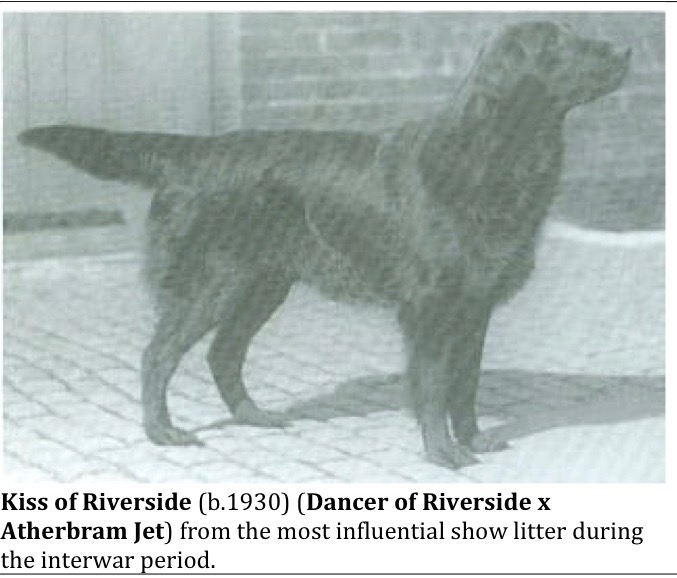
No matter what, registration figures went down and the gene pool narrowed but the leading breeders managed to maintain excellent conformation standards as well as a line of competitive gundogs. The by far most influential combination from this period was the two litters out of Dancer of Riverside x Atherbram Jet (1929, 1930) of which the offspring was shared between Cooke, owning the sire and the breeder Will Phizaklea (Atherbram). Kiss of Riverside out of this combination was considered by Cooke to be one of the best bitches he had ever owned. Atherbram Prince and Pewcroft Puzzler were littermates out of the same combination. Their descendants played major roles when the breed was restored after World War II. In addition to these Specialist (born 1928) is considered to be the dog who had the greatest significance for the restoration of good type after WWII and he was the father of one of the two Field Trial Champions appearing during the twenties and thirties.
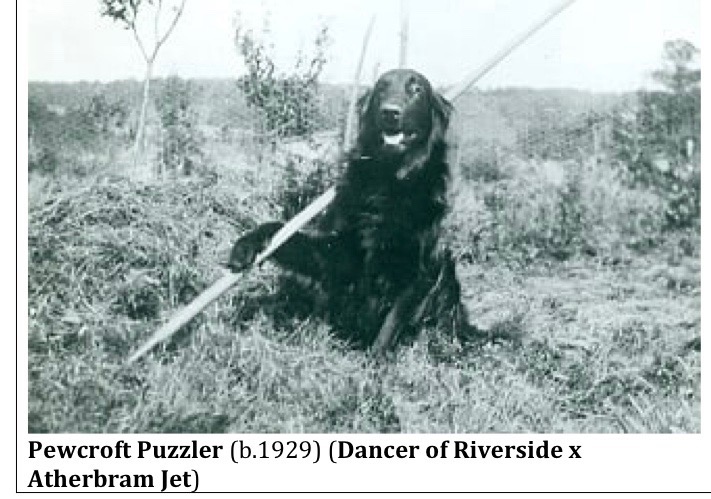
Interbreeding
As stated in the initial chapter the different retriever breeds where considered to be retriever “varieties” more than independent breeds throughout the foundation years. Although breed characteristics as we know them today were defined in the beginning of the last century, the coat and colour of the dog was for long the major criterion for showing a dog in the Labrador ring or as a Flatcoat or a Golden. During the foundation years until the end of the nineteenth century different retriever types were quite openly crossed. Long coated and short coated varieties were sometimes seen in the same litters and given different” type” names when listed at a show. Although The Retriever was separated into four different breeds just after the turn of the century, and stud books were gradually closed, options to interbreed (=matings between” cousin breeds”) was maintained for a long time. In her beautiful and most interesting book” The History of Retrievers”, compiled by Judy Seall from the Scrapbooks of Reginald Cooke in 2001, articles tell about well-known Flatcoats being used actively in Labrador breeding and how one dog could compete in the Flatcoat ring and his litter mate in the Labrador ring.
It’s obvious that qualities we consider to be characteristic for the Labrador today might have been infused from the Flatcoat strains via the melting pot that shaped the working retriever. An article in Mr Cooke’s scrapbook tells; “There must have been much interbreeding between Labradors and Flatcoats before and during the First World War, judging by the correspondence of that time. “To improve the Labrador as a gundog” it was written, Flatcoat blood was introduced, in other words to try to breed retrievers that would keep their noses to the ground and not in the air as often seen in the Labrador.” If this is true, it is interesting to reflect that the Labrador perhaps owes much of his very popular hunting style to his cousin!” The last statement is surprising knowing that Labradors today are considered to benefit from their low nose work compared to Flatcoats working with their noses held higher. The low nose work increase efficiency comparatively when the cover is rough. When there is plenty of game, a dog scanning wider areas with a high nose might even harm unshot game more easily. Was the high nose of the Labrador in those days a trait that had been infused via Pointer/Setter crosses or was it just a variation or a result of individual breeder’s choices. It must be questioned however whether the high nose is a general characteristic of the Flatcoat or something, which I believe, differ strongly between different individuals. And isn’t it so that a clever dog adjusts his nose work according to scenting conditions and the grounds.
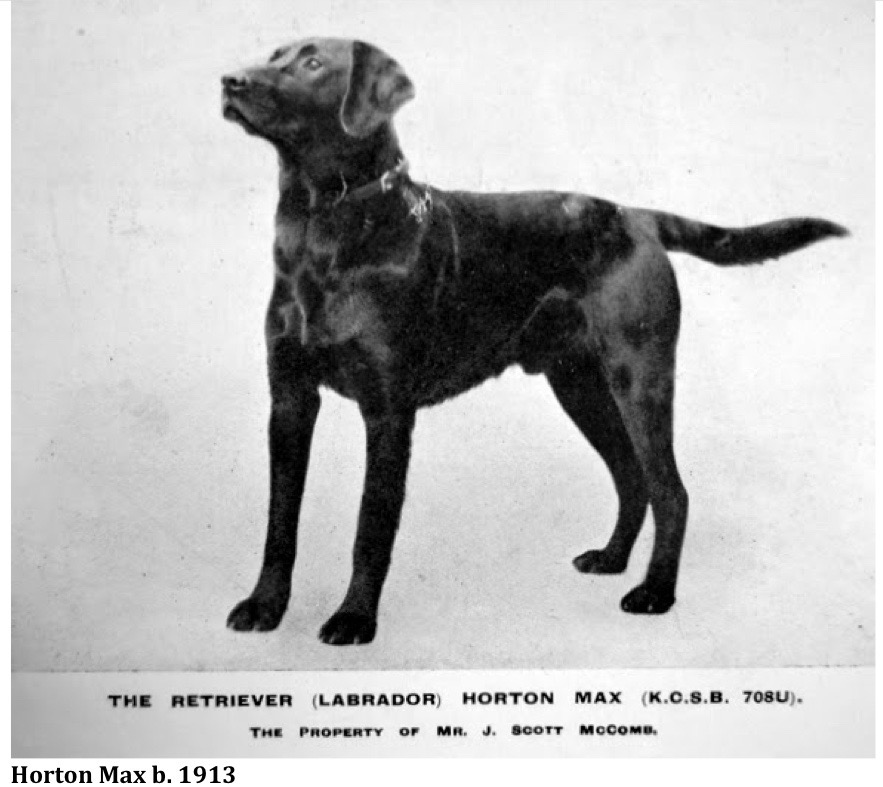
Looking at the studbook and the pedigrees of that time the frequency of interbreeding was quite high for a long time even if influences probably shouldn’t be exaggerated. Interbreds mainly had a random impact but in a few well-known cases a major one, primarily for working lines. When Flatcoats and Labradors were mixed, according to some of the articles, the visual Labrador characteristics seemed to dominate and most pups were showed and registered as Labradors. One such example was the famous Labrador CC-winner Horton Max, renowned for being a three quarter Flatcoat and one quarter Labrador. The big gaps in his pedigree indicates however that the portion of Labrador blood behind could have been much larger (huntinglabpedigree.com). It doesn’t sound unlikely as well that the positive image built around the newly launched Labrador made breeders choose the Labrador like interbred pups and to choose the fancy Labrador name instead of the Flatcoated when the choice was given.
Slowly the retriever patrons reacted on the unclear border lines between the different retriever types, as it seems, mostly in relation to the demands of the show world. A meeting was gathered in 1916 at Crufts with the intention to promote a change in the Kennel Club registration rules and open a specific register on interbred retrievers. Correspondence indicates that Reginald Cook was one of the main initiators.
In shooting circles, this interbreeding option was probably used more frequently than in show ones and it can be seen rather frequently in early working pedigrees. Approximately 30% of all British Labrador FT Champions until 1993 had unregistered dogs in their 6 generation pedigrees with a rapidly decreasing number in modern days. Although, most probably, most of those unregistered dogs were pure working Labradors, Interbreds occurred in Labrador pedigrees not the least during the inter-war period. As a curiosity, it can be noted that FT Ch Sendhurst Sweep, born 1961, considered to be one of pillars of the modern working Labrador, had unregistered dogs quite close behind in his extended pedigree and some blood that could be traced back to dogs out of interbred background. The last Labrador FT Ch with gaps in his pedigree, Leadburn Prince, was born as late as 1978. It can be noted as well that Golden FT Ch Haulstone Larry who won the Retriever championship in 1937 (the first Golden ever to be placed) had an interbred Haulstone Jenny (litter sister to Ft Ch Haulstone Bob) in his pedigree. The grandsire of Haulstone Jenny and Bob was the famous Yellow Labrador FT Ch Haylers Defender.
The Interbred became a “variety” of its own individually listed in the UK Kennel Gazette, where all registered dogs were presented. Mr Mackay Sanderson compiled what was called “The Labrador Retriever Club Stud Book and Record of Field Trials” in 1949. It covers in depth the breeding of all British retriever breeds primarily during the years from 1919 to 1938 but also to some extent the foundation years starting at the end of the previous century. 6 Interbred FT champions are listed, five of those by a Labrador sire out of an interbred bitch. The heydays of this “variety” were in the beginning of the twenties when the interbred half-brothers Flashy and Dazzle dominated the working scene and subsequently won the Classic in 1921 and 1922. According to Mackay Sanderson Interbreds competed with success at Field Trials until the end of the nineteen thirties.
Interbreds were accepted by the Kennel Club as a separate” variety “from 1916 until 1970. They were allowed to compete at Field Trials and if bred to pure bred dogs in two generations their offspring could be registered as purebred again. It was most probably the show oriented breeders who put pressure on the Kennel Club to abandon this option, that might have had some negative consequences on the quality of some show dogs. But the arguments to make this final closing of the stud books were quite weak. If an Interbred didn’t look or work according to the standards or if it didn’t add any strong values to the pure breed it was not used. We forgot as well that Interbreeding is the most effective method to infuse new blood in continuously narrowing gene pools and to improve vanishing features in the working retrievers.
You should not consider the average Interbred as a result of an ambitious breeding plan, striving to improve certain features or broaden the gene pool in a structured way. The strict breeding of pure bred dogs as we see it today was not established at that time at least not in shooting circles. The shooting man mated his gundog to another gundog in the neighbourhood and if it happened to be a first-class dog from another breed he didn’t care that much. Looking at the British Kennel Gazette from those years, where all registered dogs were presented, it’s obvious that interbreeding was quite common with a few specimens presented in each edition. But it’s obvious that the clear majority of these were just” odd shots” leaving no traces in the pure breed history.
And even if pedigrees of that day were filled with gaps you shouldn’t believe that crosses normally were hidden behind all those. If a dog wasn’t entered at a trial the owner didn’t care to waist the money to register at The Kennel Club. If the day came when he wanted to enter competition of any kind it was not a big deal to register even if there were gaps in the pedigree. It was mainly bitches that weren’t registered. It was far more important to merit the dogs and consequently to register. The dog owner could choose prefix and dog names quite freely and if a buyer registered a dog, it was often given the owner's prefix.
The phenomenon was evident in the Flatcoat. If we look at Grouse of Riverside (b.1903), one of the two Flatcoated dual champions ever in Britain, he had an almost complete pedigree for six generations. The Flatcoat dominated the Field Trial scene during these early years and Labradors were hardly visible. But the other dual Champion, Toby of Riverside (b.1919), had an unregistered mother and an unregistered grandmother and great grandmother on the sires side. Most dogs in the latter's pedigree were most likely pure-bred Flatcoats, as otherwise the show quality wouldn’t be there, but it’s not a wild guess that the working Labrador blood is there as well quite close behind, knowing about the total dominance of the working Labrador on top Field Trial level at that time. There are no known descendants of Grouse but Toby played a key role for the working Flatcoat lines.
When studying Flatcoat pedigrees back to the decades before World War II, there are more frequent gaps in the working dog pedigrees compared with the show ones. Even if most of those dogs were pure Flatcoats there’s a good reason to believe there are the odd Interbreds as well. The strong dominance of the Labrador on the Field Trial scene and the openness when it came to interbreeding must have encouraged pro work breeders to use the best possible blood.
Being a numerically small breed, it could be expected that interbreeding had been used in larger scale in the Flatcoat. But surprisingly there are only a few well-known cases of interbreeding since the nineteen twenties. Nevertheless, they have played an important role in the building of the working Flatcoat. A Labrador named Flapper, who might have been the famous FT Ch Flapper, appears in the early Ponsbourne pedigrees coming from a Welsh working line. The by far most influential one was the Labrador Coronation Jenny being the grand dam of the Interbred retriever, Bibby. She was mated to Dual Ch. Toby of Riverside and to Dandie of Shipton and her offspring came to play a major role in the working lines. Her most famous offspring was FT Ch Elwy Mary and in addition to that six others won stakes and in the coming generations her impact is obvious.
But no one should claim that the qualities in the major working Flatcoat lines are fully due to a continuous infusion of working Labrador blood. There has always been strong working Flatcoat lines. The game finding capability in a good working Flatcoat is second to none but the infusion of working Labrador blood has added a finetuning of the working capabilities, faster maturation, improved steadiness and biddability and, not the least, it broadened the narrow gene pool.
The heyday of the working Flatcoat
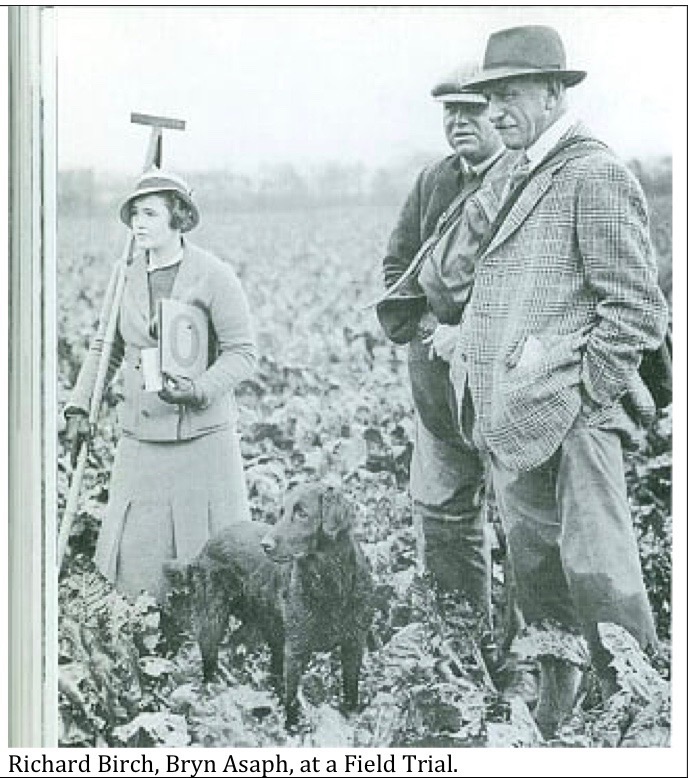
During the twenties and thirties, a group of dedicated breeders worked hard to develop a more competitive working Flatcoat and proved that working Flatcoats could compete with the best given the same breeding conditions that goes for working Labradors and Goldens. Mr Mackay Sanderson tells that “only about a dozen Flatcoat kennels were prominently concerned with the working side during this period”. He praises among others Mr R.E. Birch (Bryn Asaph), Mr Barrett (Elwy). Mr R Muir Wilson (Windle) for their contribution to the working scene and they should be praised as well for establishing the breeding base for the working Flatcoat as we know it today.
It should be noted that the competing Flatcoats were few during this period being totally outnumbered by Labradors and Goldens. Only 70 Flatcoats were entered from 1919 to 1939 and 4 gained FT Ch status from 1900 to 1939 (22 became bench champions). The fact that 87 Labradors (including 2 dual champions compared to 115 bench champions) and 10 Goldens (including 2 dual champions compared to 69 bench champions) gained FT Ch status, shows that the Flatcoat was a minor breed during this period. But knowing the fact that many of those Flatcoats won well in Any Variety competition it’s no doubt that the working Flatcoat had a bit of a golden age between the wars. Although no Flatcoats were placed in the Classic (the Retriever Championship) during those years, 6 (out of 11 dogs entered) gained Diplomas of Merit thus proving very high working standards. In total 199 retrievers competed in the Championship from 1919-1939. Of those 155 were Labradors, 24 Goldens, 11 Flatcoats, 7 Interbreds and 2 crossbreds.
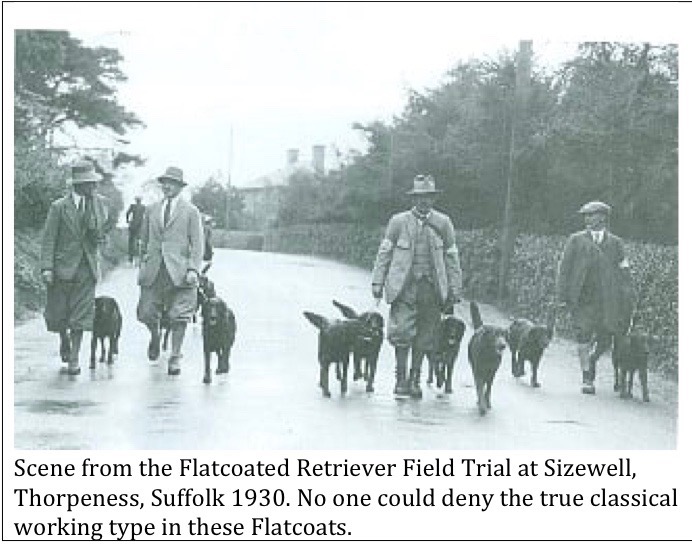
Mr Reginald Cook, of the Riverside prefix, is one of the finest exponents of a dual-purpose breeder in any breed looking back on his two dual champions in the dawn of the nineteenth century, fifty years of successful dual-purpose breeding and on his last Field Trial winners after WWII. He must be seen as one of the strongest supporters ever of the working Flatcoat, starting his career with the outstanding worker Dual Ch Grouse of Riverside born in the beginning of the nineteenth century, following up with Dual Ch Toby of Riverside during the nineteen tenth and making a grand final with Joy of Riverside (handled by Cooke’s keeper) winning the FCRS All Aged stake 1949 and 1950 and becoming second in 1951, the year of her owner’s death. Joy was the maternal half sibling of Nobby of Riverside who was second in the Flat Coated Retriever Association's last Field trial in 1948 and third behind Joy in the first FCRS Field Trial in 1949. Nobby was the grandsire of Teal of Hawks Nest
Mr Cooke played a strong role in the working retriever world and a number of Riverside dogs competed successfully during this long period and became important stud forces in working circles. But the dominant position built up by Cooke was not only discouraging other breeders, he was sometimes unwilling to allow other breeders to use his best breeding material, with negative consequences on an already narrow gene pool. However, the profound influence of the Riverside kennel can be traced into the modern working Flatcoats and its notable that International FT Ch Hartshorn Sorrel, one of the greatest working Flatcoats ever and one out of four Flatcoated Field Trial Champions since the second world war, who won her title in 1967, shows a pedigree dominated by Riverside dogs.
The two dominant breeders Reginald Cooke (Riverside) and Will Phizaklea (Atherbram) did use pure working blood from time to time. Knowing the physical requirements of a working retriever it was a natural issue as well for these breeders to maintain a working type, a true dual-purpose type, in their show lines. When they forwarded the baton to the new breeder generation starting after the war they could claim that they done what could be done to transmit a first class working Flatcoated Retriever.
The restoration years
The Flatcoat stock that remained in Britain after the end of World War II was to say the least rather limited. All breeds were affected by the war as few litters were born during war time, but the Flatcoat was hit harder than most other breeds due to the low and declining popularity before the war. According to Flatcoatdata.com there were 30 different dogs and 47 bitches used at stud in UK during the forties and approximately the same number during the thirties, most of those being closely related. But those who came to influence the future of the breed to some extent were not that many and those who had a major impact dominating the gene pool of today were even fewer. For me keeping a deep interest in the development of the breed in general and of first class workers in particular, all names are familiar when I dig into these pedigrees. All individuals were fairly close already being linebred numerous times on the Flatcoats that founded the breed. So even before the gene pool was limited.
This condition applies to some extent to all pure-bred dogs and it is important to point out that dogs obviously could stand a quite high level of linebreeding and that linebreeding is of vital importance when developing the specific features of a breed. But at the same time no breed could maintain a reasonable health level if the gene pool is too narrow. According to the US DNA laboratory, UC Davis VGL (Veterinary Genetics Laboratory), the Flatcoat has the narrowest genetical variation of all tested breeds so far. I do not know how extensive DNA material the geneticists had access to and there is still a limited number of tested breeds. But I fear that this picture will remain relatively unchanged when a higher number of Flatcoats and more breeds are tested. English dogs had previously been exported to the Nordic countries and to US but there are no traces of these lines in today's Flatcoat. All worldwide Flatcoats are descendants of the small population of British dogs that existed in the 1940s, so it’s easy to understand that the breed, despite the huge registration figures of today, has a very narrow gene pool.
But it’s no doubt that the Flatcoat had a flying start after the war and eventually became one of the most popular breeds. The foundation stock was obviously of a quite good quality. It was most probably a reasonably healthy breed then with a sufficient number of bloodlines to create a first class working dog with a suitable conformation. A small group of young, talented and very determined breeders added to that and enabled its rapidly increasing popularity. The role of Will Phizacklea (Atherbram) for building the base of the post-war Flatcoat is indisputable, having around 10 litters during the forties. No one could question the importance of Waterman and Claverdon Jet, being the foundation for the two leading post-war kennels, booth being bred Atherbram but renamed by their owners. But it was another senior breeder, Stanley O’Neill (Pewcroft), who initially came to play the dominant role.
Pewcroft Plague - an unknown Interbred
We know that the capabilities of the working Flatcoat was improved or let’s say finetuned with a few Labrador crossings. The role played by the interbred-bitch Bibby is well documented. But the story about Pewcroft Plague, born 1939, has been kept in obscurity. Being the foundation bitch for the Pewcroft kennel she played an immense role for the development of the post war Flatcoat and there are few that could challenge her role as a pillar of the breed. Stanley O'Neill (Pewcroft) was active in Flatcoat circles from the nineteen twenties until the late nineteen sixties when he died. He was one of those few breeders who could aspire to the title of being a main designer of the modern Flatcoat. Sewallis Shirley (of Ettington Hall but with no prefix), around the turn of the previous century, Reginald Cooke (Riverside), who worked throughout the first half of the 20th century, Nancy Laughton (Claverdon) and Colin Wells ("W" and later Woodland) being active during the second half of the 20th century is, in my mind, the other members of this exclusive group. In my opinion, there is only one modern breeder who has had a similar impact on the breed around the world and that is the Swedish breeder Ragnhild Ulin (Almanza).
The Plague story relates to the turbulence that appears now and then around the yellow Flatcoats. It was considered to be a major problem in the sixties when the breed began to recover and there was a widespread belief that this was due to Labrador or Golden crosses made” sub rosa”. Nancy Laughton made what seemed to be a test mating in 1962 to try to identify the yellow gene, making a quite close linebreeding to her own foundation stock as well as the Pewcroft line. Colin Wells used the yellow Claverdon Blonde Caesar out of that litter and sold a dog pup to the US breeder Mrs Sally Terroux. It’s not known to me what conclusion Nancy Laughton could draw out of the experiment.
The aging Stanley O'Neill (Pewcroft) was hospitalized in 1967. It seems obvious that he wanted to ease his conscience when it came to the yellow gene and he wrote a letter to Joan Mason (Heronsflight) who was caring for his last dogs. O'Neill told that the available bloodlines were reduced to a seriously low level in the late thirties. He obtained a bitch named Pewcroft Pest, that he had given away many years before and mated her to his old dog Pewcroft Puzzler keeping a bitch pup named Pewcroft Plague. According to the letter O’Neill soon realized that the dam wasn’t the bitch that he’d given away but a more or less pure-bred Labrador. He describes Plague as one of the best working retrievers that he’d ever experienced in any breed.
However, the story sounds, to say the least, very doubtful and I am quite sure it isn’t correct. Although Pest came from good breeding it was in no way unique. According to the letter she wasn’t a bitch of good quality. She’d been given away because O’Neill didn’t like her so why try to get her back at nine years of age? He was one of the most influential Flatcoat breeders of that day, with a deep knowledge about the classical Flatcoat conformation. It sounds most unlikely that he could mistake a more or less purebred Labrador for a Flatcoat. And if the dam was a pure Labrador or Interbred of unknown descent what are the odds to get a pup that turns out to be one of the best working Retrievers he had ever experienced?
There was an interesting notation about Pewcroft Puzzler on Flatcoatdata.com telling that he’d been mated to a famous Labrador bitch, Poppelton Black Tulip, to produce the Interbred Pewcroft Prong (born March 1939, the same month as Plague was born according to the registry). With generous support from The Kennel Club's registry I could find some further details about this Interbred. Prong was registered as an Interbred seven years later in 1946 in connection to the registration of one of her daughters (out of a working Labrador) as an Interbred and her grandson as a purebred Labrador (out of another working Labrador).

These data prove that O'Neill had access to a first-class Labrador bitch at the time Plague was born. It proves that he wasn’t unfamiliar with the idea of making an interbreeding. It proves that he had an Interbred bitch, Pewcroft Prong, that was born the very same month as the interbred Pewcroft Plague was born. Poppelton was one of the leading Labrador kennels at that time, and P. Black Tulip (look at the US site huntinglabpedigree.com) came from first-class dual-purpose lines knowing the fact that a show champion of that time looked like a modern good looking working Labrador.
It is interesting to note that there are strong connections with other interbreeding experiments at that time. The father of Poppleton Black Tulip was the half-brother of Haylers Defender being the first yellow Labrador ever to become a Field Trial champion. Defender was the grandfather of the Golden Retriever FT Champion Haulstone Bob. His sister Jenny was the granddam of Haulstone Larry, being the first Golden Retriever ever to win the Retriever Championship in 1937. The Labrador Knaith Banjo, most probably the last retriever ever to win a dual championship in England, in the late 40's, was out of a Poppelton dog being closely linebred to P. Black Tulip and her litter brother Ch Poppleton Black Lancer.
In an email from the Labrador man and dog historian Rickard Edvards he tells that there are several Lab/Flatcoat Interbreds in the extended pedigrees of these Poppleton dogs. According to him, the Outhwaite couple, who had the Poppelton kennel, was open for experiments and they had most likely used a Foxhound cross to improve the yellow Labrador lines.
In accordance with the ideals that were common in the Flatcoat world at that time, colours other than black was undesirable in the Labrador world. Although there has always been yellow Labradors it took a long time before they were fully accepted. Mary Roslin-Williams, well-known Labrador breeder, show judge and author, tells that Chesapeake Bay Retriever Blood was used to improve the yellow Labrador lines. According to her it explains why "broken" coats similar to that of the Chessie occurred quite frequently in the yellow lines.
The brown Labrador had its breakthrough after World War II and according to Mary Roslin-Williams, the colour was established via brown Pointer crosses in the show lines (the brown gene doesn’t exist in the working lines). Therefore, the brown Labradors had quite untypical and ugly heads and she tells that a Flatcoat cross ("with one of the best Flatcoat dogs of that day") was made” sub rosa” after World War II to improve the heads of the brown Labradors!
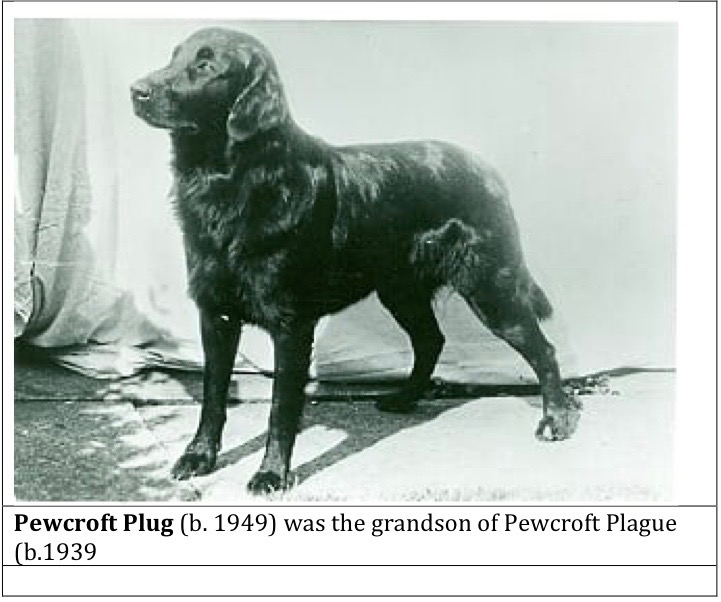
To conclude, I am convinced that O'Neill was given the opportunity to do an "interbreeding" with Puzzler and a Labrador bitch, most probably being Poppelton Black Tulip. He picked the pup with the strongest Flatcoat character. He followed the easy way and used the pedigree of a Flatcoat bitch he’d given away to register the pup as Pewcroft Plague, a pure bred Flatcoat. It is strange fact though that he didn’t choose to register Plague as an Interbred. It was fully acceptable at that time, but maybe it was not seen as appropriate in the small circle of Flatcoat breeders so dominated by Reginald Cooke (Riverside). Or it could be so that the Outhwaite couple, who probably owned the bitch, wanted to use some offspring from the very same litter to improve their Labrador lines” sub rosa”.
Poppelton wasn’t just one of many Labrador kennels. In a discussion thread on labradorforums.co.uk it’s stated that Poppelton was one of the most influential kennels of that time, starting with Black Tulips brother, Ch. P. Black Lancer, with an immense impact on the modern show Labrador as well as the working one … and as it seems on the modern Flatcoat!
Plague, which was the best working dog O'Neill ever experienced, had only one registered litter. I believe, however, that Plague and Prong was the very same bitch but when O'Neill wanted to register the working Labrador crossings he made with her and her daughter, she was registered as the Interbred she really was.
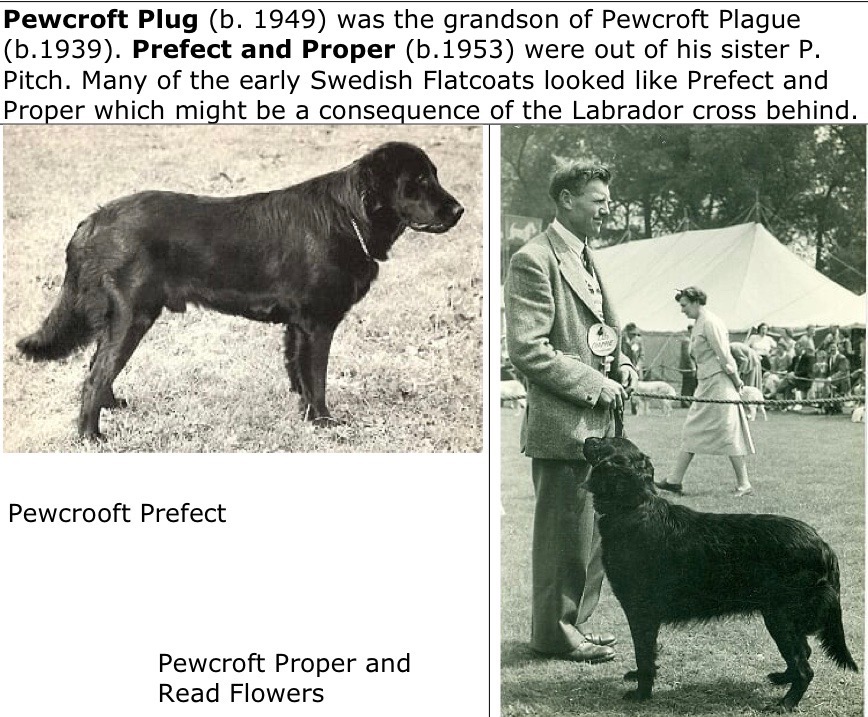
Nancy Laughton (Claverdon) used several Pewcroft dogs when she built up her Claverdon kennel beginning in the nineteen forties, heavily influencing the” W” lines of Colin Wells. If we consider the fact that Read Flowers (Fenrivers), Barbara Hall (Blakeholme), Amelia Jessel (Collyers), W.H. Hutton (Yarlaw), Joan Mason (Heronsflight) and Patience Lock (Halstock) founded their lines on close descendants of Pewcroft Plague, starting during the nineteen sixties, we have captured all the major breeders that could be named the founding fathers of the modern Flatcoat.
The last Interbreds
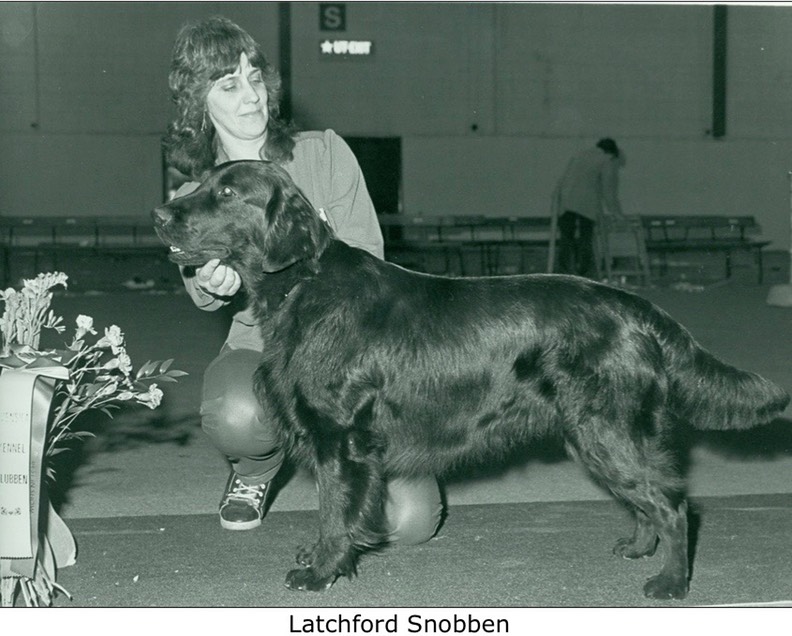
The rule of the British Kennel Club allowing Interbreds was abandoned in 1970. In 1969 Collyers Blakeholme Brewster, owned by Mrs Amelia Jessel, was mated to two Scottish Interbred bitches out of a similar breeding with a named Golden Retriever dog appearing two generations behind (was it in fact one and the same bitch noting the common birth date or just a strange coincidence?). A grand-daughter, Matilda of Halstock, was exported to the Fla-go-line kennel in Norway and a litter sister, Mimosa of Halstock to the Caymosa kennel in Sweden. Mimosa became a show champion and had several litters in Sweden and Norway having a quite strong impact on the breed with two show champions among her offspring. One of Mimosa's best-known descendants was Latchford Snobben, one of the first show dogs competing successfully on group and Best in Show level but her genes are present in many different lines. Bramatha Copper Najinsky, who was the grandchild of the second bitch, was imported by Ragnhild Ulin. He was a nice little workmanlike type of dog being used quite extensively at stud. It seems to be well justified given that he was an outcross to the dominant breeding lines. If I remember correctly, one of Colin's Wells dogs was used on a Scottish interbred bitch from a Flatcoat/Golden cross as well but at is seems she’s left no visible trace behind.
Although these Interbreds had a quite visible impact on the Swedish and Norwegian Flatcoat there are few significant traces of it in the British stock although they appear somewhere behind the Belsud, Westering and Staverton lines.
The role of Pewcroft Plague is radically different. We will probably never recapture the full story behind her, but its most likely that she was 50 % Labrador and it’s no doubt that her offspring had a major impact on the modern Flatcoat. O'Neill's post-war lines started with Plague. She had one single mating to Atherbram Warrior bringing in two close lines back to Dancer of Riverside x Atherbram Jet, and thus to her father’s litter. Two daughters of hers came into use. One of those Tess of Tolcarne mainly appears behind the Rungles and the Ponsbourne dogs. The other one, Pewcroft Peg, was mated twice. The first one being an outcross bringing in six lines to Specialist. The second one to Sweep of Riverside brought in another line to Dancer of Riverside X Atherbram Jet, but a pedigree being dominated by the interwar working Flatcoats.
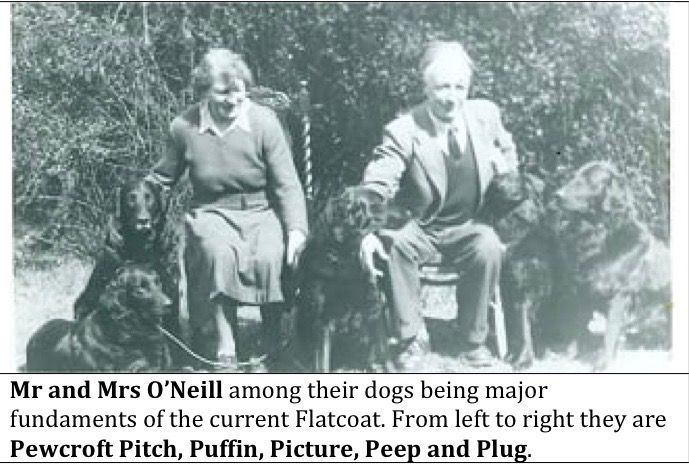
I believe these matings were done according to the school book when a very strong outcross is made. At first class Flatcoat type was stabilised via a close linebreeding to the strongest show lines of the thirties. Secondly a huge amount of blood was brought in from the interwar working Flatcoats and thus as well from the Interbreds contributing to generations of true dual purpose Flatcoats. These were, mainly bred for work but still keeping in mind that a sound and balanced conformation and a good type is crucial even for the working Flatcoat. Doing so O'Neill could establish a strong line of dual purpose Flatcoats contributing strongly to the Flatcoat we see today.
Type in a working Flatcoat
The Labrador man and Championship winner Ian Drury once told me that a working Labrador that doesn’t looks good won’t be attractive at stud. I believe he cited his friend John Halstead, of the famous Drakeshead Labradors, I’m sure most owners of working retrievers could agree to that. Experienced breeders/owners of working gundogs look for a balanced, nicely moving dog, true to type as long as it’s built for work.
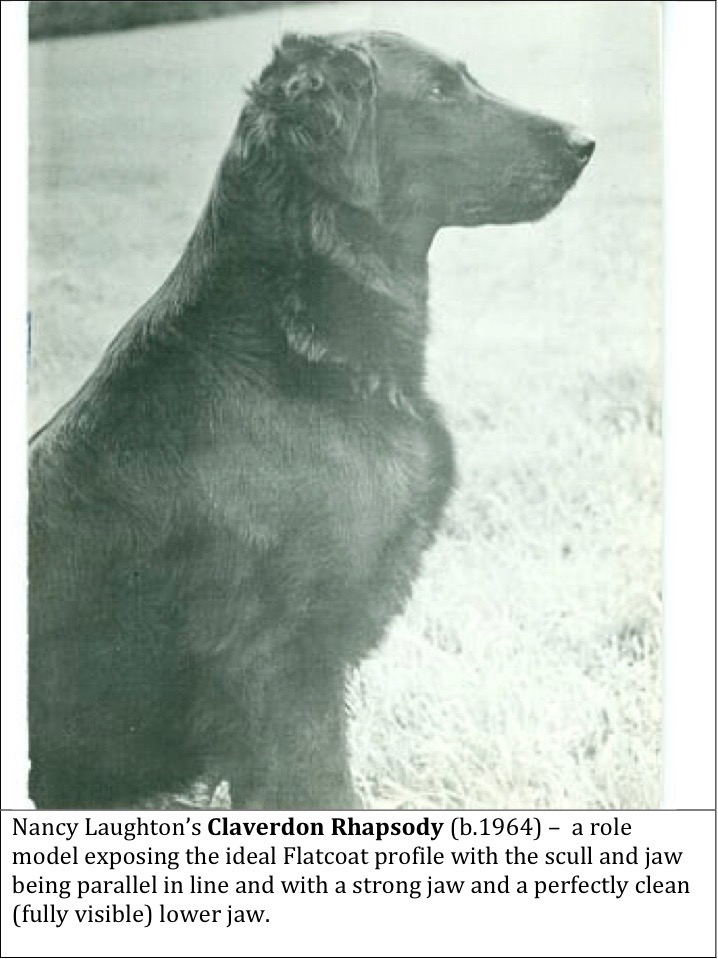
O'Neill was the one who conveyed the classical Flatcoat conformation ideals to the new breeders watching a breed with the most varied and often rather untypical appearance. He maintained a column in one of the major dog magazines continuously arguing for the improvement of the breed. He” translated” the classical breed standard, being defined in the beginning of the century, into understandable details and he described the classical proportions of a Flatcoat head. The length of the skull and the length of the jaws should be almost equal. There should be a slight stop between the eyes. Skull should be moderately broad but wide enough to give eyes an intelligent expression. Jaws should be strong with sufficient depth, the back of the jaw should be straight and parallel in line with the” flattish” but nicely moulded head to avoid a borzoi like, down faced, profile. Large hanging lips is a disadvantage for a working Retriever trying to get rid of feathering from a freshly shot pigeon and the lower jaw should be clearly visible on the ideal Flatcoat head profile.
O’Neill’s missionary role was gradually taken over by Nancy Laughton who had a very strong voice as well and wrote a comprehensive biography about the breed,” A Review of the Flatcoated Retriever”. Type was of utmost importance when trying to rebuild a cohesive breed. The two of them wrote recurring articles explaining what a typical Flatcoat should look like.
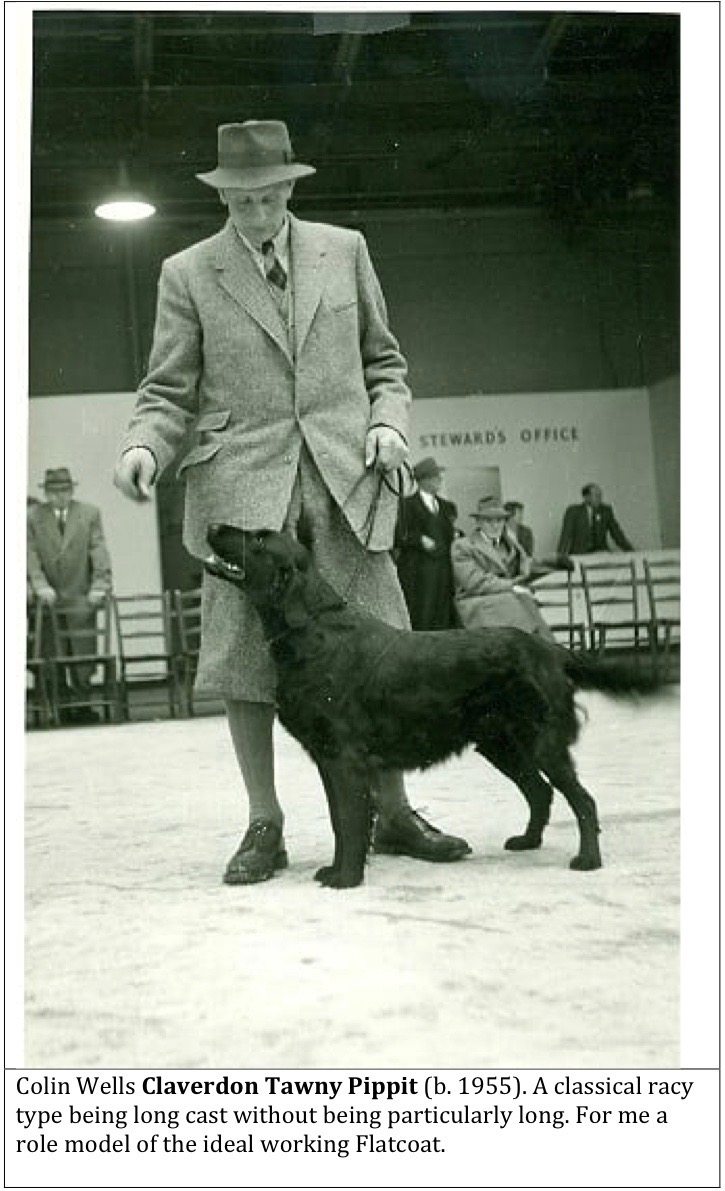
Nancy Laughton and Colin Wells were the strongest advocates for a show type that shouldn’t deviate from the image of a working retriever. The dual-purpose ideal has always been about keeping a show dog shaped by the timeless requirements of the shooting field and not by the fashion of the day, dictated by any variety judges looking for potential group or BIS winners. The size of the dogs varied most significantly at that time. Nancy and Colin made a common statement that the ideal size of a male Flatcoat is about 58 cm (23 inches) and a bitch being slightly smaller and, consequently, that size should be allowed to vary both upwards and downwards a bit. Those measures were later included in the breed standard but it’s hardly followed by the modern show Flatcoat.
They argued for a racier Flatcoat as well but Colin was the one who argued most strongly for an ideal type with "a short body and a short wagging tail". According to him, the working dog was favoured by a comparatively short body, contributing to a tight and efficient search pattern providing a good style in the field. The long back that has become fashionable at today’s shows generates a wider hunting pattern. It’s a disadvantage for a working retriever supposed to circle very closely, when needed, and it’s probably the reason for the persistent myth about the Flatcoat being a bit of a setter hybrid. When appearing its a result of a targeted breeding towards a more setter like type and there is no evidence indicating that the original Flatcoat had a higher portion of Setter blood than the other Retrievers.
If you study the great show winners from the early days, they were often almost four-square when comparing the height at the shoulders and the length from the withers to the tail set. The typical slightly elongated appearance was shaped by the unbroken but slightly curved line from the neck to the tail tip, of a moderately long neck, a long, moderately curved and deep chest, of the 1: 1 ratio between the depth of the chest and the length of the front legs and of a tight muscular constitution. This is what the author of the original standard was aiming for with the term "racy” (= racehorse). Elegance is something different.
Finding rare bloodlines
Nancy Laughton (Claverdon), Stanley O'Neill (Pewcroft) and Patience Lock (Halstock) were the ones who made the greatest efforts to find and use rare blood lines during the restoration years. Long before the modern network technologies were established it was a huge challenge to find "peripheral" breeders around the UK and many of these were gamekeepers who never showed or trialled their dogs. Thus, other breeders could successfully process their breeding material to the benefit of a broader gene pool. The only other modern breeder I know of who made significant efforts to find rare blood lines is the US breeder Ed Atkins whose Wyndham dogs have had a major impact on the US Flatcoat.
The one and only prominent English breeder who chose her own paths at that time was Margaret Izzard (Ryshot). She established her kennel in the late 40's and as it seems she was continuously trying to produce liver Flatcoats. Although well-known dogs from other breeders were used her blood lines were running alongside the Flatcoat main lines. Her kennel was established in 1947 with Ryshot Starlight, a bitch out of two unregistered parents from unknown breeding supposed to be pure Flatcoats. But knowing some of her Swedish descendants I would guess there was a portion of Labrador blood behind as well.
Starlight appeared in the pedigree of Ryshot Copper Fire, who had a strong impact on the Swedish foundation stock. Studying his quite odd looks, cobby body and his heavy head, you could easily get the impression of a Labrador effect. But it might as well be an example of the dramatic variations in type during these early years. Strangely enough, he had several beautiful and talented offspring. The first Swedish Field Trial champion, Ann Stranders Puh's Frigga, and her litter sister Puhs Dam af Fjolner, being one of the foundation bitches of the Danish working line, were sired by him as well as a number of Show champions.
The liver colour was strongly questioned during the early years and although the odd liver pup appeared now and then few breeders focused on the colour. During the thirties, there were two competing breed clubs in Britain, one of those was trying to get the colour excluded from the standard. However, when the war was ended these clubs joined forces and formed the current club, the Flatcoated Retriever Society. I presume that livers are fully accepted by the modern breeders and that the days are over when ignorant breeders are questioning odd colours for bringing bad features or bad health.
Focusing on working ability
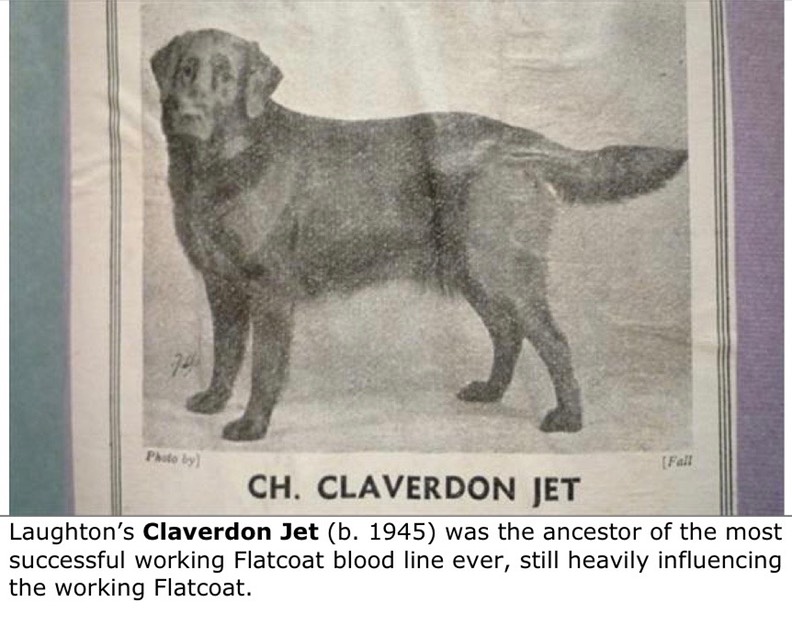
Although O'Neill's Pewcroft dogs had a huge impact when the breed was re-established, it must be said that Nancy Laughton's Claverdon Jet became a kind of starting point for the restoration of the breed after World War II. Jet was bred by Will Phizaklea (Atherbram) in 1945 but registered under the Claverdon prefix. Her sire came from the main show lines of the thirties with the Dancer of Riverside x Atherbram Jet combination close behind. Her dam was a pure-bred working Flatcoat with the Field Trial Champions Elwy Mary and Windle popular just a few generations behind. Claverdon Jet won the bitch certificate at Crufts and she had many merits from the Field Trial scene being reserve in two Open stakes. Although she was quite far from the standard we could see today, being a bit on the coarse side, she became the start of a line that dominated the working lines for over fifty years. But it’s no doubt that her descendants had a strong impact on show lines as well.
When the restoration of the breed was started after World War II, the leading breeders focused on its working skills, keeping in mind a typical and functional conformation. The most influential dogs had a strong portion of blood from the working lines of the nineteen thirties. As always breeders linebred to the best individuals from the previous generations. Int. FT Ch Hartshorn Sorrel, the most successful Field Trial Flatcoat of all times, was repeatedly linebred to the working dogs of the inter-war period, she had two lines close back to the Interbred Pewcroft Plague and close to fifteen lines back to the Interbred Bibby. But there is no doubt that she was the most typical Flatcoat. Her litter sister H. Sweetbriar was the mother of Colin Wells show winner Wood Poppy and her brother H. Samphire played a significant role behind the Hutton's Yarlaw dogs.
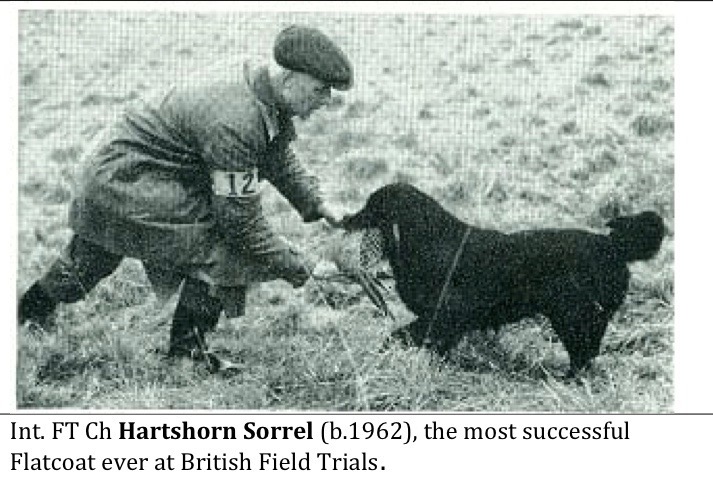
It is important not to misinterpret this picture. After all, we are talking about dogs from the major dual-purpose lines. The interbreed component contributed to a widening of the significantly narrow gene base, which would have had a beneficial effect on health at the time and contributed to the refinement of the working qualities. Hartshorn Sorrel was probably the best example. She won 25 awards at field trials in England, Scotland and Ireland during the 1960s, becoming an International FT Champion and getting a Diploma of Merit (a "Quality Prize") at the Retriever Championship. No other working Flatcoat has been close to that quality level in the Flatcoat Field Trial history.
The dominant show line from Darenth to Vbos The Kentuckian
Colin Wells returned from military service in West Afrika during these years and in 1945 he obtained Waterman as a young dog from Will Phizaklea. Colin went there to buy a puppy but he saw Waterman in the kennel and managed to persuade Phizaklea to sell him. Colin followed the tradition he’d established before World War II and registered him with a name beginning with "W". Waterman came from prominent show lines with three lines quite close to the Dancer of Riverside x Atherbram Jet combination. It was therefore not surprising that he came to be the start of the male dog line dominating the show scene until today. He was the great show star at that time having Field Trial merits as well.
Claverdon Jet was mated to Laughton’s own dog, Revival of Ettington, whose dam was bred by Colin Wells before the war. Wells has told that he took his motorbike to collect the bitch pup named Claverdon Faith, becoming the foundation bitch for his kennel. It might have been at that time the tradition was established where Colin paid Doctor Nancy (as he always called her) with a stilton cheese from his local dairy? Wells was a low-paid gamekeeper (later Head keeper on the Belvoir Castle estate near Grantham) and Laughton, a laboratory physician with a seemingly good economy, considered it to be a major task to provide gamekeepers with first class working dogs.
The offspring out of Waterman and Claverdon Faith had an unmatched significance for the development of the breed. Waterman won Best of Breed at Cruft's for four consecutive years and his son Workman (out of Claverdon Faith) succeeded him for five consecutive years. However, Workman couldn’t match his brother Waterboy as a stud dog. Waterboy was the outstanding Field Trial dog during the nineteen fifties winning numerous breed trials. Wells stated that he would have conquered the Dual Ch title if he had the time to campaign him at any variety trials. Knowing that he was at the top at the FCR trials for seven years and gaining a 2:nd prize in Open Class at one of the few Any Variety trials he entered its no doubt he was close. But Wells was a heavily occupied game keeper during the shooting season with limited time for trialling. According to him the great show winner Workman wasn’t as easy to handle as his full brother. Waterboy, although being a show champion, couldn’t match his brother when it came to looks.
Wells probably never kept more than 4 - 5 Flatcoats at a time and they had to work all days throughout the shooting season. You could imagine that it was about one of the bigger shooting grounds, and a hard work for these dogs, mentioning that close to a nine hundred pieces of game was shot during the very best shooting days. When it was time for Crufts in December each year, Wells initially took his bike and two or three dogs the mile down to Grantham's station and the train down to London, where Crufts took place at that time. He once told me that the most awesome experiences for him were those times he went to debut a young dog at Crufts winning his classes and eventually best of breed. His dogs were primarily bred and conformed for work but these days a first-class worker could win at a show and he enjoyed keeping the good looks.
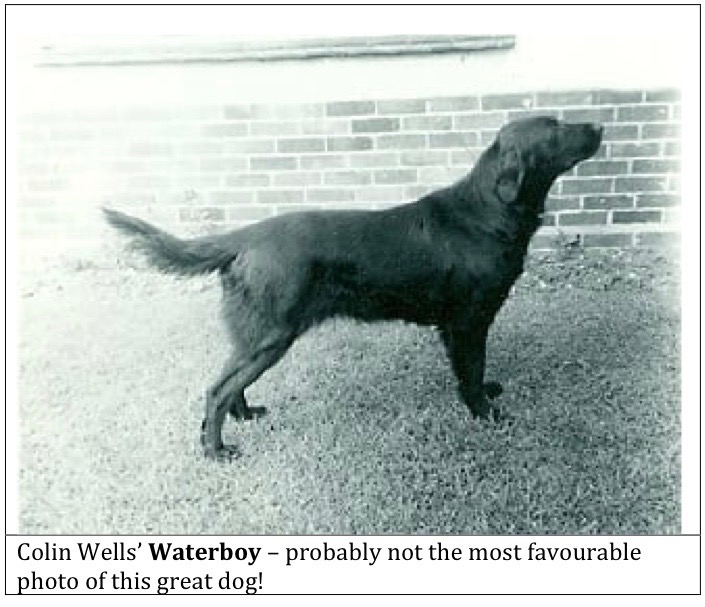
Waterboy and his son Woodlark were the ones who came to play the role as "breeding motors" being the subject for continuous linebreeding for Wells himself throughout his career as well as for many other breeders. Some of Waterboy’s descendants in straight male line are; Woodlark, Fenrivers Golden Rod, Tonggreen Sparrowboy, Damases Tarquol or Ryshot and Shargleam Blackcap. Practically all those dogs have won certificates at Crufts and practically all the following winners have come from the same male line until last year’s winner Vbos the Kentuckian. All these dogs have belonged to the most influential stud dogs of their time. It’s a fact that this dominant male line goes back to the dawn of the breed during the second half of the nineteenth century back to Darenth and in a straight male line via Horton Rector, Black Quilt, High Legh Blarney, Jimmy of Riverside…Dancer of Riverside…Waterman etc. That is how a uniform breed is built, for better or for worse!
Turning into a show breed.
Shargleam Blackcap won Best in Show at Crufts 1980, being the first Flatcoat ever to gain this prestigious title, a sensational victory that became something of a turning point for the breed. Nancy Laughton’s and Colin Well's lines were largely represented in Blackcaps pedigree and he was actively used as a picking up dog, but still it was the start of a new era. Starting with Blackcap the breed became fitted to match the very best in group competitions and BIS finals and it has remained ever since.
Breeders of the foundation generation had started to reduce their dog activities for natural reasons, although many of those had the occasional litters until the very end. Wells’ dogs had their share of show wins till the end but during all these years the main focus was on the working side. During his heydays in the ring, Wells told me, he didn’t care staying for group competitions when winning his many BOB victories. At least it wasn’t important at that time and he had to hurry back to his pheasantries. The passion for the breed never ended and Nancy Laughton was around 85 when she had her last litter and there was a bitch registered under the Claverdon prefix four years later. Claverdon Raffles of Collyers, a dog from her very last litter, being closely linebred to the Tarncourt Noteable litter, had a great influence that is still visible in the modern British working lines.
However, new breeders stepped into the scene and the breed followed the inevitable path towards a division in show and working lines. The show breeders are using their bloodlines and the work oriented are using theirs, a division becoming more evident for each generation. This break might be most appearant in Britain, where there are very few examples of show bred dogs appearing at Field Trials. Its a simple truth that you can’t win on any scene today without a high degree of specialisation.
It has been a parallel development in Sweden, and probably in most other countries. Latchford Snobben and Lady Doc's Natanael, were two of the first to compete successfully on group level in Sweden during the eighties. But Almanza Larry O'Grady must be accounted for the great breakthrough of the breed in the show ring, winning BIS at the great Stockholm dog show 1991 and at twenty other occasions. He was close to the top in the any variety “dog of the year” competition and a quite good worker. His son Almanza Emergency Break more or less copied his fathers achievements, being dog of the year in Sweden 1995. He was one of many examples as well where Larry’s offspring won the dual champion title.
The Working Flatcoated Retriever Group
The pro work oriented British breeders were worrying about this trend. It was quite obvious that a rapidly growing number of show oriented breeders had little or no interest in the working qualities of the breed. A number of concerned breeders tried to counteract what was perceived as a gradual deterioration of the working Flatcoat capabilities. By a strange coincidence I happened to visit Nancy Laughton in 1985 when the Working Flatcoated Retriever Group was founded. A number of breeders met at her place in Henley-in-Arden. Joan Marsden (Tarncourt) was the initiator with strong support from Nancy Laughton, Gwen Knight (Claverdon) and Amelia Jessel (Collyers). Read Flowers (Fenrivers) would have been there, the aging Colin Wells (W) supported the group, and there were a number of other names that is not that visible in the breed history. It was not supposed to be a club of its own but just a working group with dedicated breeders, acting within the Flatcoated Retriever Society, to promote a competitive Flatcoat, able to hold its own at Field Trials competing with working Labradors and Goldens.
Articles about the working Flatcoat were published in the Shooting Times and The Field and contacts were established with gamekeepers and shooting men around Britain to find good workers that weren’t up for competition. A few of those were taken into use to broaden the working lines and gamekeeper dogs such as Bridport of Musk and Boy Joe were successfuly taken into use. Amelia Jessel initiated the Shooting Dog Certificate, an evaluation of shooting dogs that ain’t up for Field Trial competition. The test is still in use and it takes place during a regular shooting day with official Field Trial judges examining the dogs. If the dog is found to be an effective working dog without any disqualifying faults, its awarded with a Shooting Dog Certificate (SDC), being registered in the Kennel Club stud book.
However, the active members were too few and the group was questioned by the show oriented breeders considering it to be a threath towards their somewhat diffuse dual purpose ideals. It was just a parenthesis in Flatcoat history and I fear that the average current breeder hasn’t heard about its existence. Nevertheless there is still a strong working Flatcoat culture in Britain with many breeders maintaining good working lines and not too few having the occassional litter based on pure working blood. But the dominant breeders/trainers/handlers who are consistently winning at trials are few today and I believe its not unfair to say there is noone today matching Nancy Laughton, Amelia Jessel and Joan Marsden as frontrunnners in the gundog world.
Working Flatcoats in Sweden
In Sweden, and to a large extent in the other Nordic countries, there is a quite unique situation with Flatcoat clubs quite strongly focusing on working abilities. The Swedish Flatcoat Championship is a world-class event with 300 to 400 participants each year. In 2015 there was a peak figure with 500 Flatcoats visiting southern Sweden for a two day working test and with a significant number of participants from all over Europe. That figure will be matched in 2017 with 500 Flatcoats competing at a venue outside Stockholm. There is probably no other retriever club around the world able to show such figures. Knowing there are less than 800 Flatcoats registered each year in Sweden its obvious that a high percentage of all dogs are exposed to gundog training and many of these are used for picking up purposes. But with such an impressive width and so many talented and ambitious handlers there should be a higher peak. Going back to the eighties a number of Flatcoats could match the very best working Retrievers in Sweden and three of them won the Retriever Championship, at that time being a cold game trial, but we are not there anymore.
During the last decades of the twentieeth century a significant number of Flatcoats competed successfully on top level in all nordic countries and a few gained the Working Champion titles. There were a few clearly visible working strains in Sweden and Denmark continuously producing first class workers. During the nineties about 600 Flatcoats competed each year at Swedish cold game trials. But that figure has gradually gone down to around 300 the last year and the number of those competing at the very top are fewer. Although there is a quite significant number of breeders strongly focusing on working qualities there are few examples of working strains with a high percentage of top performers and where top winning dogs are producing a top winning offspring for generations. The Swedish wonder when it comes to global show winners is in no way matched by top performing Field Trial dogs. But it’s in a way an encouraging fact that quite a few Flatcoats out of show bred Flatcoats are competing quite successfully at trials and tests. It could be claimed that this proves that the dual purpose dog is still there. But the uniformity of these show bred litters is probably very low if you compare working capabilities with show ones.
For some peculiar reason linebreeding on top performing dogs have been strongly questioned in Swedish working Flatcoat circles. When a British breeder is trying to find a linebreeding option many Swedish breeders are constantly looking for a seemingly unrelated dog. As a rule few or no topwinners over the years have been the subject for linebreeding. In this respect there is radical difference comparing pro work breeders with the show ones. Consequently it’s hard to find visible working lines today although there are many talented and targeted pro work breeders.
Tonggreen Sparrow Boy
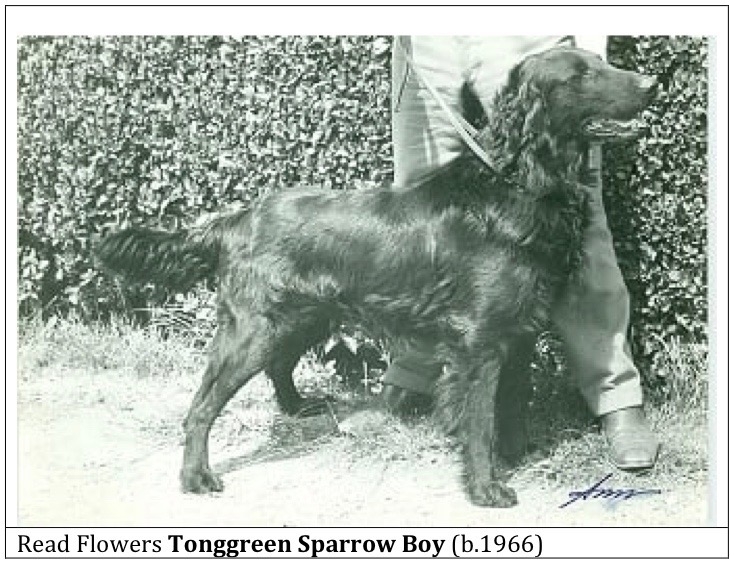
Although the breeding material originally was the same for the show and work oriented lines in England, different dogs dominated as ”breeding engines”, meaning dogs targeted for linebreeding. Different breeders focused on different qualities that could be beneficial for their own breeding targets. In the show oriented world, Tonggreen Sparrow Boy (born 1966) became a role model, a trendsetter. Read Flowers, who owned him, stated that he shouldn’t be targeted for line breeding, not being spontaneous to shot game and showing a quite reserved manner. Flowers had to teach him to retrieve by sending the father (Fenrivers Golden Rod) after the son of the same bird and the competition made Sparrow Boy retrieve at last.
But Sparrow Boy had many good looking show winning sons and daughters. He’s been the target for a frequent linebreeding and he’s probably the one who’s had the greatest impact on today's show dogs around the world. This also applies to Sweden, and I could count a few years ago that Sparrow Boy appeared between 150 and 200 times in the extended pedigrees of a few Swedish top show winners. This is by no means unique and most successful show dogs in different countries are likely to have a similar number of occurrences in their pedigrees, although the number varies. There are of course other dogs having a similar impact. But when breeding for a particular ideal type in any breed, dogs being the best representatives for the prefered type are automatically multipled numerous times in most pedigrees, gradually narrowing the gene pool.
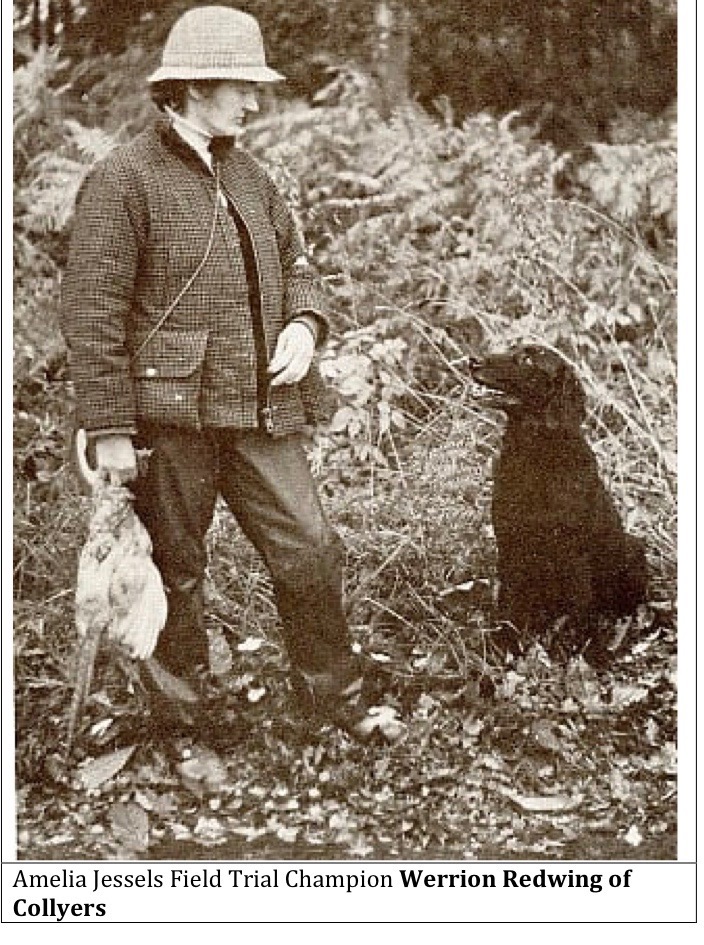
Knowing the shortcomings of Sparrow Boy as a shooting dog, how could his granddaughter, Amelia Jessel's, FT Champion Werrion Redwing of Collyers (b.1973), become such a successful working Flatcoat? She is one out of four British Flatcoats since World War II who have conquered the UK FT Champion title. The litter brothers Tonggreen Sparrow Boy and Starling were her grandfathers. However, Redwing had 10 lines back to Waterboy, giving the drive and stamina that could balance the softness, responsiveness and steadiness that was seen in Sparrow Boy’s offspring. The same applies to the lines behind O'Flanagan Free-As-Air (b.1975), still being the record holder at Swedish cold game tests when it comes to the number of first prizes. I’m quite convinced that he would have matched the best if he had entered proper Field Trials as well, but there were no in Sweden at that time. In his case, Sparrow Boy was the paternal grandfather, and there were 20 lines back to Waterboy.
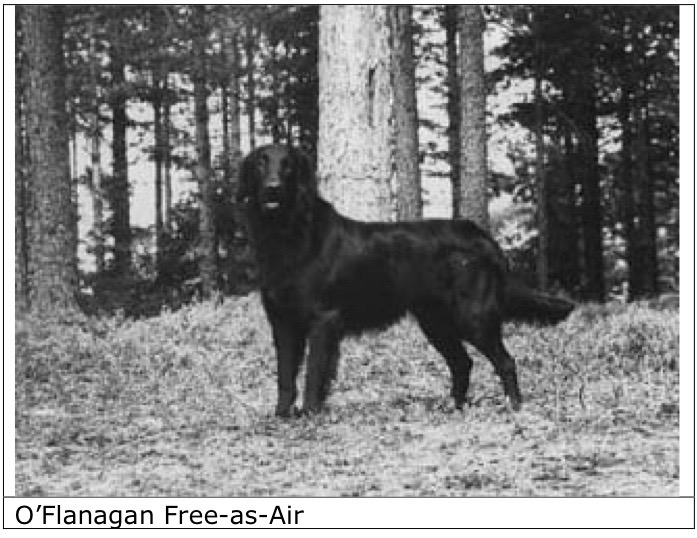
The very first Swedish Flatcoat competing succesfully on Best in Show level, Almanza Larry O'Grady, had numerous lines back to Sparrow Boy as well. But the impact from the "W" dogs was even stronger and the fact that eight offspring of his were prized in elite class, three of these with FT Champion titles, was probably due to that. If I mention that Larry had about 190 (!) lines back to Colin Wells Waterman, most of those via Waterboy and his son Woodlark, this relationship becames understandable even though the first occurrence of Woodlark was more than six generations back. If you compare the portrait of Larry with the one of Colin Wells Crufts winner Woodlark, the relationship becomes very clear. But don’t misunderstand me. Larry is just an example and the corresponding "multiplier effect" is seen in all major show winners and to a varying degree in all Flatcoats
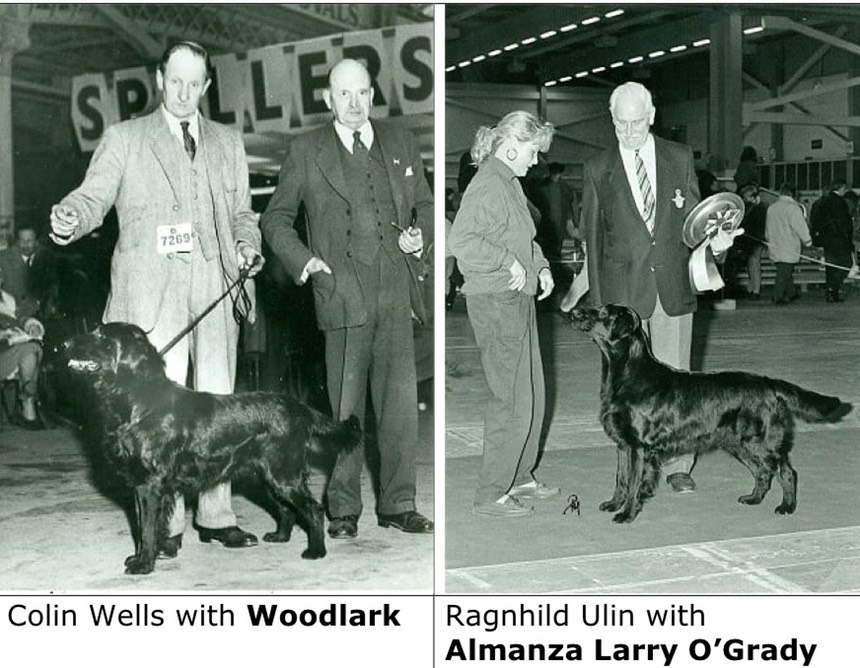
Teal of Hawks Nest
Teal of Hawk's Nest had a similar impact on its offspring and subsequent generations as Sparrow Boy had. He was bred by O'Neill (Pewcroft) and came from strong working lines. He got a significant impact on the working strains and he sired some of the best FT dogs in the breed. But he influenced the show lines as well and his beautiful head had a strong impact on his descendants. He was the sire of Int. FT Champion Hartshorn Sorrel, the most successful British working Flatcoat ever, and Nancy Laughton's great F-litter, Claverdon Fantasia, Flyer, Fidelity, Felicity, Flapper, Fulmar, where almost all individuals had a strong impact on the working lines. He was the father of Heronsflight Tercel as well with a number of litters having an immense impact on the show as well as working lines.
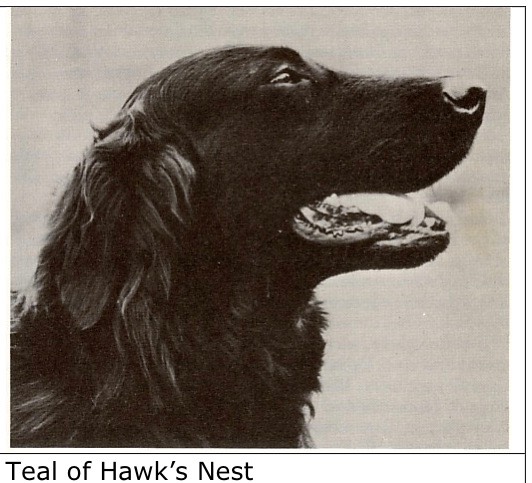
Nancy Laughton once told me ”don’t linebreed to Teal, you’ll get lazy pups” and I saw several examples of dogs where Teal was dubbled and a few dogs with Teal and Sparrowboy very close behind. They were exceptionally powerless dogs being strongly unwilling to retrieve game! This is a good example showing the difficulty to balance a soft and biddable disposition with the drive and stamina needed in a first class worker. It shows as well the importance to make an in depth analyses of a pedigree to find out which capabilities are reinforced in a litter. A controlled linebreeding is a tool to shape a litter according to your own wishes, instead of a breeding that randomly multiplies the presence of less desirable individuals.
Looking at Sparrow Boy's six-generation pedigree on Flatcoatdata.com, it clearly shows his origins. As for Teal of Hawks Nest, the Pewcroft dogs starting with P. Plague, dominates and there’s a number of lines back to the Labrador crossings that are represented behind this line. This is probably an important reason why yellow puppies have become quite common in the breed. But the rather phlegmatic and somewhat reserved manner seen among their descendants, probably caused by the Labrador crossings, have been beneficial to some extent for the working Flatcoat. The distinct "on and off button" that must be in place in a competitive gundog is probably due to them. I believe that the typical and quite charming Flatcoat character, constantly trying to convince every one around that he/she is the only important person on earth, needs to be balanced in a working retriever.
In England, Sparrow Boys great grandson Shargleam Blackcap, played a similar role as Sparrow Boy for the show lines. Vbos the Kentuckian, winning Best in Show at Crufts in 2011, is passing Blackcap in the overall winners league at British shows. According to flatcoatdata.com he has three lines back to Blackcap, but in fact, Blackcap appears 12 times behind and Blackcap littermates another 5 times and Sparrowboy appears between 50 and 100 times in the extended pedigree.
In a similar way Nancy Laughton's (Claverdon) dogs and Joan Marsden's (Tarncourt) dogs have been targeted for linebreeding in the working lines. Its easy to follow the red thread from the early Claverdon dogs, via the Teal of Hawks Nest infusion, via the Claverdon "F" litter and via Tarncourt Noteable to the best dogs of today. But you can’t see any individual dominating the scene as Sparrow Boy and later Blackcap. Although the working lines are fewer, the dominant dogs are used less frequently and I am quite convinced that the genetical diversity is slightly larger compared to the show lines.
Linebreeding for better or worse
I left the active dog scene many years ago and for the time being there is no dog at home. But I can’t help following the breed at a distance and of course there are many good friends left in the retriever world. It turns out that much has changed since our active years. When we had our first Flatcoat bitch in the early 70's, hips were x-rayed and almost always found to be perfect, eyes were checked and a few cases of cataract appeared. After some years, the first cases of patella luxation were diagnosed. But at that time, the short life span of the Flatcoat was already a problem. Noone of the eight Flatcoats we owned over the years became older than ten years, a few died in the early years and all died from cancer. I can’t remember there were other hereditary diseases appearing but I’m sure there must have been a few. I had the specific Swedish role of being a breeding advisor in the 70:ties and the chairman of the Flatcoat club during the 80s, so I should have known about any major problems. The breed was very small then and in 1971, when our first Flatcoat bitch was born, seven litters were registered. Nowadays I can see recurring articles about different hereditary diseases that seem to plague the breed. There is much talk about the narrow gene pool and it is a ongoing discussion about how to broaden it.
The strive for perfection in all breeds, no doubt, has the consequence that the most prominent dogs in each generation are multiplied countless times in all pedigrees. Even if we don’t always realize it, all targeted dog breeding, regardless of the characteristics we are looking for, is built on a large amount of linebreeding and its hardly possible to avoid. Even though two individuals appear to be relatively unrelated in a 3 - 5 generation pedigree, it becomes a corresponding linebreeding/inbreeding if the same dogs appear at a significantly greater number of times in a 6 - 7 generation pedigree or even more if you go further back.
Vbos the Kentuckian derives from Colin Wells Waterman in an unbroken male dog line and has a nearly countless number of lines back to him. Waterman, in his turn, had three close occurrences of the most prominent show combination of the 30:ties, Dancer of Riverside x Atherbram Jet. From Vbos the Kentuckian via Waterman, there is a straight, unbroken male dog line back to Darenth, born 1888, which is considered to be the patriarch of the Flatcoat, being multiplied thousands of times in all Flatcoat pedigrees. That’s how a uniform breed is created for better or worse!
The early British breeders, as I’ve mentioned in this article, always looked for line breeding opportunities. I believe it has always been so and that it’s still the case, even if I’m quite far away from the current show dog world. When a top performer appeared in an overall descent litter, plans were immediately made to linebreed to him or her in the following generations. Thus, well known characteristics from the previous generations could be reinforced/stabilized in the following. Dogs considered to be outcrosses were made now and then to enable continuous linebreeding, keeping in mind the importance of a genetical diversity, built on solid knowledge from centuries of targeted and successful dog breeding. It occures to me that breeders almost always followed what seemed to be an unwritten norm, to repeat the targeted individual in the second and third generation on each side, to get it close enough but not too close.
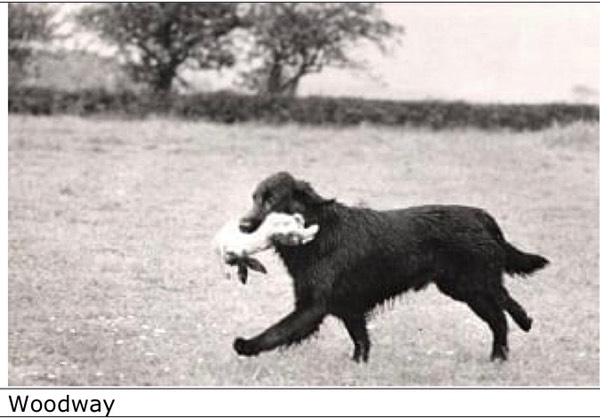
In few exceptional cases cousin matings occurred. Woodway, who played a significant role for the early British as well as Swedish lines, was the result of such mating with Woodlark appearing as grandsire on each sides. But the grandames were fairly unrelated and it was probably a planned mating due to a lack of available blood lines at that occassion. Although Woodway was a good dog, producing a healthy and useful offspring, this is hardly to be recommended. The risk of inbreeding defects is unnecessarily large and today the progeny may not be registered or at least strongly questioned among the other breeders.
But isn’t the line breeding tradition one of the main reasons for many health problems visible today? Its probably so at least to some extent. Its a fact that the original genepool derived from the gene pool of the nineteen fourties is narrow. The strive for perfection in all dog breeding, and the linebreeding to the top performers of any kind, tends to increasingly narrow that. As I’ve mentioned before DNA analyses of the US Flatcoat stock indicates that the Flatcoat gene pool is more narrow than any other breed. That has to be confirmed or denied via further analyses of the British, Nordic and continental European gene pools. But all Flatcoats around the world originates from the British dogs of the fourties and I believe no one could question that it must be one of the main breeding targets to broaden the current gene pool.
Linebreeding - a tool to broaden the gene pool?
It maybe sounds to be contradictory, but I am convinced that a conscious linebreeding is in fact an important tool for a broadening of the gene pool. If most breeders linebreed on the very same lines, to the very same individuals, the breeding base will be further narrowed for sure with negative consequences for health. It is most likely that its frequently done today even if we don’t think about it. But if the DNA tool is used to find in depth outcross dogs and if conscious breeders are trying to build ”more unique” blood lines linebreeding to these ”more unique” individuals I’m sure the gene pool will be broader. If such a breeding is based on a good historical knowledge about these lines, I am convinced that this tool can be used to develop capabilities that need to be developed and increase the genetic variation simultaneously. As long as we strive to refine the capabilities of the breed not the least when it comes to competitive working features we can’t give up a conscious linebreeding as a major tool.
But we might have come to a status within the major show lines where conformation standards are sufficiently homogeneous to allow for an extended usage of proper outcrosses, and perhaps the lacking genetic diversity within the show lines force us to outcross to a larger extent. I’m sure many work oriented breeders could provide healthy, mentally sound, typical and wellbalanced individuals even if they don’t fully fit the current show ideals. But to broaden the gene pool and counteract the clearly visible inbreeding effects I’m sure the working Flatcoat lines could provide a wide range of outcross opportunities, enabling linebreeding back to show lines in the following generations.
Within the working lines, genetical variation is likely to be somewhat larger and the arguments for line breeding stronger. The active breeders, who have been on the working scene for many years, are probably the ones to respond. But looking at the available statistics from the Nordic as well as British tests/trials there is a distinct downward trend with fewer Flatcoats reaching the highest prices in Open/Winners/Elite whatever its called and I’m afraid it looks very much the same in most other countries. One clearly visible consequence of this is that many skilled breeders / handlers look for other breeds and the downward loop is strengthened. Knowing that we can’t throw away options to use a conscious linebreeding to reinforce the proportion of genes from the rather few individuals and lines with a proven ability to compete at a high level.
Interbreeding today
I was asked to step in as chairman of a crising Swedish Spaniel and Retriever Club for a few years at the beginning of the millennium. Due to severe conflicts between the show-oriented and work-oriented members of the club it was about to be divided into a work oriented and show-oriented club. I thought it could hit the Flatcoat particularly hard, I raised my voice in an article and was conseqently asked to step in as the chairman to try to preserve a cohesive Spaniel and Retriever club. I presume there was noone else willing to take the role at that time, but there were two interesting years were we succeeded reasonably well to maintain one joint Swedish Spaniel & Retriever Club.
One of the most memorable moments for me these years was the hosting of the Spaniel Championship at the Öster-Malma estate, the training center for the “Swedish Hunting Organisation”. Directly after the award ceremony, when everyone was still gathered in front of the mansion, a Clumber Spaniel bitch was mated to a participating Working Cocker. The mating was sanctioned by the Clumber Club, by the Spaniel and Retrievklubb and the Kennel Club. I have talked now and then with a representative for the Clumber club. She tells that the cross have been very successfull and fully reaching its targets. After three generations, the offspring have been judged by two specialist show judges and have been considered to be typical Clumbers. Thus they were registered as pure bred Clumbers in the SKK registry.
In the fourth generation, several individuals have won show certificates and the project has been welcomed by breeders in many countries. A male from the fourth generation has been exported to England. It has been used by a breeder who breeds specialized working Clumbers and a young dog from that litter has gained a price at an Any Variety Field Trial. Of course, the dam was priced before on the same level but it hasn’t happened in the breed since the 1930s. Breeders have been able to take a step to broaden a very narrow gene pool and as it seems many breeders are aware that such controlled interbreds need to be executed at several occasions.
The Flatcoat has most probably a considerably narrow gene pool compared with the other Retriever breeds and conditions might be similar to the Clumber although the total number of registered puppies are significantly higher in the Flatcoat. In order to extend the genetic variation and counteract the narrowing gene pool I believe we could learn from the Clumber and apply for an interbreeding program in the Flatcoat breed. In my belief it should logically be about crossing a typical working Flatcoat with a well chosen working Labrador out of solid and healthy black lines.
If done in Sweden the offspring is registered in the so-called X-register at the Swedish Kennel Club. It must be given the opportunity to participate in Working tests and Trials open for all Retriever breeds but the first two generations have nothing to do at shows. Ideally the offspring should be available for any breeder but I’m quite sure that the Kennel Club/SSRK would require a few well planned and certified matings to pure Flatcoats for two further generations.
To be successful these Interbreds must be attractive enough for a few committed breeders to be used for breeding. It’s important that these puppies come to experienced and well-motivated owners who want to train and compete with the best of them at tests/trials and be prepared to breed. It’s important that we keep type and conformation quality as well as working features strongly in mind when we breed back to pure bred Flatcoats. When Flatcoat breed characteristics most probably are restored after three generations, and the basic working features are examined and verified to be on a good level, the relevant individuals are examined by two specialist show judges. If considered to be of a proper type they are certified as pure bred Flatcoat by the judges to be used by other breeders according to the normal set of rules agreed upon within the club.
What are the risks?
If you look through the Retriever history, there is a self-regulating factor eliminating dogs that ain’t up to the standards when it comes to looks and performance. Dogs that doesn’t meet reasonably high demands when it comes to looks and working abilities won’t be used and if that’s the case with these interbreds their genes will rapidly disappear just like the vast majority of Flatcoats that are never bred from.
You might ask if the breed will turn into something totally different if working Labrador (or Golden retriever blood) is added to the genepool? I should say its vice versa. The infusion of Working Labrador and Golden blood is a significant part of the breed history. Interbreeding has been done many times before and probably more frequently than we know of during the early years. What we would do is to restore something that we’ve lost, we would add a significantly broader gene pool, we would restore working capabilities that’s been diluted over the years and we would probably get strong arguments for doing this again and probably again without risk losing any vital part of the dog we love.
We are well aware of the risks of the narrowing gene pool. We can easily show that all Flatcoats around the world go back to a very small population in England after World War II. We have statistics from insurance companies (at least in Sweden) showing that the Flatcoat has serious health problems, and a shorter life span than the average pure bred dog, that are likely to be caused by the narrow gene pool. Studies made by the UC Davis DNA laboratory in the United States, proves that the breed has the most narrow genetical diversity of all tested breeds. I am quite convinced that the Breeding Committee of the Swedish Kennel Club (SKK), at least, would approve a request from a well motivated, knowledgeable and brave breeder who, in cooperation with the Swedish Flatcoated Retriever Club (FRK) and the main body, the Swedish Spaniel & Retriever Club, would apply for making such an experiment. I am also quite convinced that there are no risks to open the studbooks to allow interbreeding according to the same principles that were admitted in Britain until 1970 but thats another story.
Use DNA tests to find and maintain rare blood lines
I’m sure that all active breeders knows about and actively use the eminent site, Flatcoatdata.com. It is a giant database of historical and current dogs from all over the world, created by knowledgeable breeders registering their own dogs and, in particular, dogs that are bred from. Its built on the same principles as Wikipedia. The fact that many critical eyes examine the data, the quality of the material can be maintained. It is a great source of knowledge for those who seriously want to search for outcross lines, as one can easily find a six-generation pedigree for a dog and look back from there, and it is a great alternative to the open Swedish ”Rasdata.se” register where all registered data about Swedish dogs are listed with full details. Practically all Flatcoats in the world can be examined to find out about the profile of their pedigrees, about dogs dominating among their ancestors and to find what seems to be proper outcrosses.
There are few countries in the world, alongside the United Kingdom and the United States/Canada, where old Flatcoat populations are maintained to the same extent as in Sweden and Denmark. This also applies to some extent to Norway and Finland, although the earliest Flatcoats in these countries originate from Sweden. There is also for sure early blood lines in Netherlands and Belgium as well as in Australia and New Zealand. But in all countries around the world, recurring English and, to an increasing extent, Swedish exports tend to play a dominant role, which means that the gene pool around the world tends to be quite even.
I believe its fair to say that international allround show judges tend to favor the increasingly uniform fashion of the day, a type of dog fitted to win at group and BIS level. It makes targeted breeders use dogs corresponding to this type, contributing to a process where the dominant individuals are continuously multiplied and less common ones deselected in pedigrees. In order to maintain the width of the gene pool, it must therefore be of utmost importance to try to find old unusual local blood lines as an important complement to the breeding that is always dominated by the great winners. Breeders around the world have an important task to identify and preserve these old local lines.
DNA tools, like the one that is developed by the UC Davis Veterinary Genetics Laboratory in US, will hopefully be a standard tool for most breeders to define and use dogs with more unusual DNA-profils. At a cost around 40 EUR and a cotton tops a DNA sample can easily be retrieved, sent and analyzed by the UC Davis laboratory. It’s important to state that this type of DNA-analyse is only used to find the relationship between different individuals and it has nothing to do with analyses done to find defect genes or genes carrying a risk for bad health.
If a large number of stud dogs are analysed the DNA - profile could be used as one of many criterions by everyone looking for a potential stud dog. Given the choices between a few equally good individuals the DNA - profile could be used and over the years the genetical diversity could be increased. The technique itself is extremely reliable. But I believe a few more steps needs to be taken by the Laboratory and/or supporting applications to simplify the search for true outcross dogs and the evaluation of alternative dogs when breeding plans are set. But every breeder/stud dog owner can start today and order a low cost test from the UC Davis lab (and probably other labs) to add to the research material and the Flatcoat DNA - profile Database.
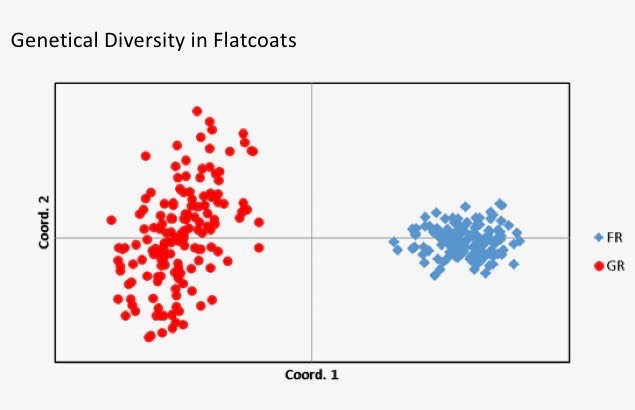
Flat Coated Retrievers have one of the lowest levels of breed-wide genetic diversity that UC Davis VGL has identified in any breed. Looking at the UC Davis VGL graph aside one can see how clustered our breed is. The comparison using the Golden Retriever was used for the graph because both breeds had similar numbers of dogs tested at the time of the reporting.
Please read more about DNA diversity testing of Flatcoats in Barbara Kriegers reports
Where are we heading? Where do we want to be?
I read an article many years ago where the legendary show/dual purpose Labrador breeder, Mary Roslin Williams, argued for the need to look back now and then and evaluate how the breed did change, why it happened and where we want it to be in the future? The patrons of a breed need to take that role and to raise their voices if it’s turning in the wrong direction. Who does that today if things need to be transformed one way or the other?
When I fell in love with the Flatcoat almost fifty years ago it was for sure another breed and I’m sure it will be another breed fifty years from now. Few people are aware of the minor ”daily” changes but if we step out now and come back in ten years we can be sure there is another Flatcoat we’ll meet. Frankly speaking, noone could deny that the show world in general tends to favor a dog that is higher, heavier, shorter on the legs, more longcast and more heavily coated/feathered than the dog the working man prefer. It’s visible in most gundog breeds and its probably visible in most other working dogs. Changes go slowly but if you look back you will see that changes are there. I don’t question the qualities of the great winners we’ve seen over the years. They are beautiful dogs but they have changed. Are we getting closer to the perfect Flatcoat or do we want to turn them slowly in another direction going forward?
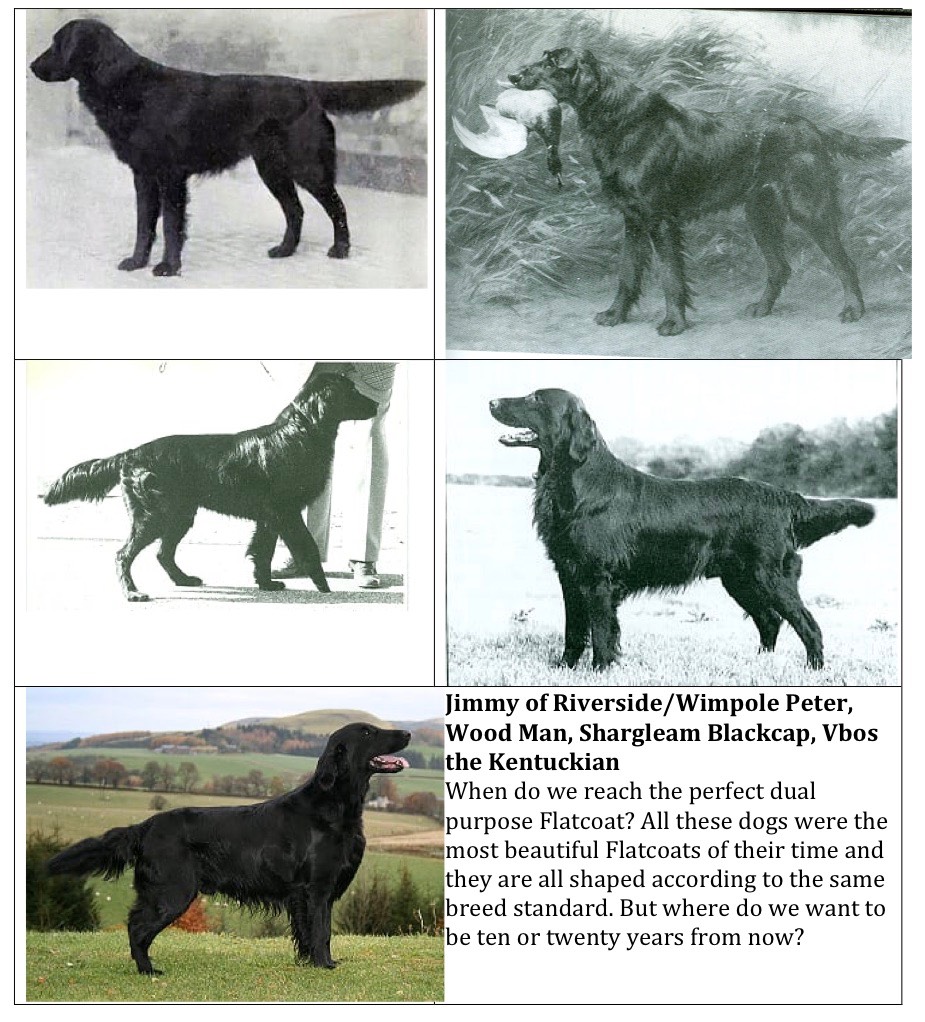
I don’t have a strong opinion myself about those things. It’s maybe a law by nature that showdogs turn bigger and heavier and if the average breeder/dog owner like those dogs I don’t mind. But if we want to enable dual purpose Flatcoats, meaning dogs having the capacity to win in the field and at shows they need to be physically fitted for that. If the field requires an easy going, fast dog able to quarter grounds continuosly in a close pattern, able to easily jump a 1 meter fence up and down, able to work all day without being tired by excessive weight or bone, being handy sized for the car or the boat then it couldn’t deviate too much from a working Labrador or Golden.
It’s fully inline with the Flatcoat standard that was written one hundred years ago and gradually fine tuned over the years. It’s about a racy dog and a racy dog is more like todays Labradors than a show Flatcoat, its about a truly medium sized dog being 58 - 61 cm high measured at the withers. It got to have a reasonable lenght of legs, not being leggy but according to some of the old hands there is a 1:1 ratio between the height of the forelegs and the depth of the chest in a functional dog. We can’t change over night but we could start to encourage and award a somewhat lighter and smaller dog with a defined ambition to get closer and closer to an ideal dual purpose Flatcoat type. It’s not up to the allrounders to define that. It’s up to the breeders governing the breed clubs and it’s mainly up to the Flatcoated Retriever Society to walk in the forefront.
If we gradually transform the show Flatcoat and the ideal working Flatcoat to a more uniform type we could more easily ”crossbreed” between those lines to the benefit of a wider genetical diversity and thus to a more healthy Flatcoat.
Where is the working gundog within 10 – 20 years. There is for sure a strong working gundog culture in Britain, in the Nordic countries, Netherlands, Belgium, Germany, USA and some other countries. There is an encouraging number of breeders in many countries trying to maintain and develope the working lines. But there is a downward trend in the competitive capacity of the breed. There are gradually fewer Flatcoats competing on top level in trials and tests. Fewer dogs are getting into the higher classes at working tests/Field Trials, fewer are entered in any variety classes and very few conquers FT Championship titles today.
The working Flatcoat is measured against working Labradors and Goldens whatever we say. I don’t agree with those saying that the Flatcoat is different from the other breeds being slower to mature, being less biddable/lacking willingness to be directed, being slower/ getting tired more easily because they are bigger/heavier, hunting in wider circles because they are more longcast/more setterish or less effective because they are Flatcoats or that it’s just about the good trainers choosing other breeds. Maybe the average Flatcoat is but it hasn’t always been and it doesn’t have to be. It’s just about breeding, it’s about the priorities we make, it’s about how determined we are, it’s about how we cooperate cross border to breed a better and more competitive gundog.
I believe it’s about setting a program for all of us:
1 To increase and
promote the diversity of the Flatcoat.
The Flatcoat today is mainly bred for company but as well for shows, obedience,
agility, police work, guide dog work, gundog work etc. To promote such
diversity it must be a responsibility for the show world to promote a multi
purpose Flatcoat type, according to the original ideas of dog shows being a
test bench for a more functional and typish dog and not just for beauty
competition.
2 To promote and
increase the genetical diversity of the breed.
The show world tends continuously to promote a more uniform dog and doing so
it’s probably unconsciously decreasing the genetical diversity of the breed. If
we promote targeted breeding for different purposes; for utility purposes, for
gundog work and for shows we will for sure promote genetical diversity. And if
we preserve and strengthen local Flatcoat strains we will promote genetical diversity.
But we need a tool to evaluate the genetical diversity, we need a plan to
DNA-test all dogs used for breeding and a simpel manual explaining how easy such
tests can be used by the individual breeder to increase genetical diversity.
And not the least we need to promote diversity using dogs across the functional
borders being it between dogs for shows/gundog work/obedience just for the sake
of genetical diversity.
3 To evaluate and
execute an interbreeding program.
Labrador/Flatcoat
interbreds and to a lesser extent Golden/Flatcoat interbreds is a vital part of
the Flatcoat heritage. Such crosses have been made to produce the Flatcoat we love
today. An infusion of working Labrador blood is probably the most effective
mean to restore the Flatcoat as a first class working dog. But the main argument
for making interbreds is to increase the genetical diversity being of crucial
importance for the health of the breed. An interbreeding program could probably
only be justified and accepted for health reasons by the Kennel Clubs. But most
probably the arguments for the Flatcoat is stronger than in most other breeds.
The improvement of the working Flatcoat will most probably be a very valuable
bonus if we do it right.
4 To evaluate and
promote the Flatcoat as a working gundog.
The
Flatcoat was originally a working gundog and the most prominent gundog in
British shooting circles. For different reasons it has lost its position. But
gundog capabilities it a vital part of the breeds heritage and if we loose
those the Flatcoat will most probably be another breed. There are still numerous
talented work and dual purpose oriented breeders around the world trying to
breed a competive working gundog. It must be a vital task for the breed clubs
to follow up, evaluate and support these actions and set targets for the
restoration of the Flatcoat as a first class gundog and to increase the attractiveness
of the breed among shooting men and women. But last but not least don’t blame
the show breeders for the shortcomings of the working Flatcoat. You, work
oriented breeders, have to make it on your own! You’re the one with the
competence to breed a competitive working Flatcoat and you and your friends
around the world have to save/reshape/develope it on your own!